King James Bible History
Lorem ipsum dolor sit amet, consectetur adipiscing elit. Ut condimentum scelerisque dapibus. Proin eget diam euismod.
Potential Precursors to the KJB – A Parliamentary Bill
In our last post we took up the first alleged precursor to the commissioning of the KJB at Hampton Court, the decision of the 1601 General Assembly in Scotland to revise the Geneva Bible. Here we take up a second potential precursor to the commissioning of the KJB, an undated parliamentary bill for a new Bible.
The Text of the Bill
B.F. Westcott drew attention on 7 Nov. 1872 to a draft for an act of Parliament from the Elizabethan era providing a “remarkable detail in the history of the English Bible, which seems to call for further investigation” (x, n.1). Sadly, little “further investigation” commenced, and to this day the bill remains largely unstudied. In fact, none of the past studies have discovered that actually two copies remain of the parliamentary bill titled An Act for Reducing of Diversities of Bibles…. One is in the parliamentary archives of the House of Lords (HL/PO/JO/10/1/1, here or here), clearly Westcott’s. Another is in the British Library (BL Add MS 34729), first examined and endorsed by John Strype (1643-1737) and later transcribed by A.W. Pollard here.
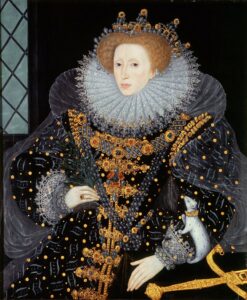
The “Ermine Portrait,” oil on panel by William Segar, c. 1585, of Elizabeth I, wearing black dress and the Three Brothers jewel, holding an olive branch symbolizing peace. Held at Hatfield House, Hertfordshire, England. WikiMedia Commons.
The bill raises alarm about “the multiplicity of errors” brought about by “the variety of the translations of Bibles” warning that papistry and atheism might by this variety win out (a common pair of boogymen in the age). It claims that “many from the high to the low of all sort have been desirous greatly and a long time” for a translation from the original languages in such a way that readers “should in no place be snared.” Arguing that the main reason (“chiefest obstacle”) this has not yet been done is the lack of legal compulsion of scholars and funds for them, it repetitiously compels six or more students of both universities to assist the archbishop in crafting a new translation “which will tend to her Majesty’s immortal fame.” In 1541 Thomas Cranmer’s urging of a new translation by “the learned of both universities” (Strype, 136-137) received pushback. The procedure partially materialized in the 1568 Bishops’ Bible. This bill seems to echo some of his original plan.
The text from HL/PO/JO/10/1/1 follows. I modernize spelling, some punctuation, and silently expand contractions. I also occasionally note features in brackets not normally transcribed, to give a sense of the material makeup. Variants marked BL in brackets are from Add MS 34729. Variants marked P in brackets are unique to Pollard’s transcription. Variants marked HL are unique to HL/PO/JO/10/1/1.
An act for [BL – add “the”] reducing of diversities of Bibles now extant in the English tongue to one settled vulgar translated from the original.
For avoiding of the multiplicity of errors that are rashly conceived by the inferior and vulgar sort by the variety of the translations of Bibles [P – “Bible”] to the most dangerous increase of papistry and atheism. And whereas many from the high to the low of all sort [BL – “sorts”] have been desirous greatly and a long time to have the holy book of God, which for the Old Testament is in Hebrew and [BL – omit “and,” which is added above the line with a marker in HL] for the New all originally in Greek, to be translated in such sort that such as study it should in no [HL – “wise” struck out] place be snared; which work no doubt the Lords Spiritual of this Parliament, with the painful travails of such of both universities as they shall or may call [HL – a second “call” crossed out at start of new line] unto them, may with the grace of almighty God perfect, which will tend to her Majesty’s immortal fame, being amongst the Christian princes universally known to be not inferior to any in the furthering and defending of the faith of [P – adds in brackets “Christ, and whereas”]. And [BL – omit “and”] the chiefest obstacle to the building of this godly work heretofore hath been discerned to be for that no compulsory means hath been had nor made whereby the students of both universities may be compelled to assist the said Lords Spiritual in [BL – repeats “in” at start of line] the painful examination and execution of the said work, nor how the charges of such students and laborers in the same vineyard may from time to time be competently defrayed.
Be it therefore enacted, by the Queen’s most excellent Majesty, by the assent of the Lords Spiritual and temporal and the Commons in this parliament assembled, and by authority of the same, that the Lords Spiritual of this [HL – “are” crossed out] Realm that now are, and in succession hereafter shall be, or any six or more of them (whereof the Lord [HL – “Achb.” contraction crossed out] Archbishop of Canterbury for the time being to be one [BL – omit “for the time being,” “to be one” struck out, “to be one for the time being” added]), may at their pleasure from time to time assemble, treat, and deal touching the accomplishment of the said work; and may by their letters call and appoint such students of both universities to assist them in the same from time to time as by them shall be thought requisite; and to allow such sums of money towards the charges and pains of such students that shall be employed in or about such work, to be levied by censure ecclesiastical as to the said Lords spiritual or any six or more of them (whereof the Archbishop of Canterbury for the time being to be one) shall be thought meet, the said charges of such students and workers to be assessed, levied, and gathered of such Cathedral churches and colleges and the revenues thereof, as by the said Lords Spiritual, or any six or more of them (whereof the said Archbishop of Canterbury to be one) shall be thought requisite. And under their hands and seals ordained and [HL – “and” repeated; BL – “and” struck out, and “or” written with marker above the line] appointed.
[HL – And that it shall and may be lawful – “be lawful” struck out, all underlined, and sentence repeated]. And that it shall and may be lawful to and for [BL – “to or for”] any temporal person by deed, gift, or will, to bestow any gift or legacy of money or goods towards the supporting of the same charges. And such gift or will to be put in execution by decree or censure of the Lord Keeper of the great seal of England, or Lord Chancellor for the time being, upon any complaint or information to him given, in her Majesty’s court of Chancery in that behalf.
The Date of the Bill
Does the document predict the 1568 Bishops’ Bible or the 1611 KJB? It is clearly from Elizabeth’s reign (1558-1603). John Strype dated the BL copy to John Whitgift’s primacy (1583-1603) in an endorsement on folio 77r which has been followed by many: “The form of an Act Concerning translation of the Holy Bible From the original Hebrew and Greek. To compel any of either University to come and assist in translating. Archbishop Whitgift. During the reign of Elizabeth. xxi.” (pg. 331). The bold lettering represents an earlier endorsement in a darker ink, above and below which Strype has written his expansions. Could he have erred in his date? Pollard seemed slightly less certain, dropping a “probably” over Strype’s dating (pg. 329, n.1). Westcott dated the parliamentary copy “certainly” after 1560 (x, n.1), seeing clear reaction to the Geneva Bible but no reason to narrow further. He would not have known the BL copy endorsed by Strype. The parliamentary copy lurks in the archives between items dated 1514 and 1566, the official calendar (pg. 4 here) placing it between entries for 1548 and 1562-63 and dating it “1558 or after” (following Strype), the same information in the online archive communicated by a date in brackets. However, entries are often not chronological.
An analysis of the shifts in attitudes towards the English Bible in England is in order to establish a framework for dating. Cameron MacKenzie’s brilliant dissertation demonstrated that the Geneva Bible’s reception by establishment England morphed through two different periods; 1) 1560-1575; 2) 1575-1582, to which we add a third; 3) 1583-1603. Each period roughly corresponds to the primacy of three successive archbishops of Canterbury: Matthew Parker, Edmund Grindal, and John Whitgift, though he warns against connecting the periods too closely to personalities.
Geneva from Publication till the Death of Parker (1560-1575)
The first period, ending with the death of Parker in 1575 (pg. 135), displayed “an official reluctance to embrace the Geneva Scriptures” (pg. 24), widening the chasm between conformism and dissent (chapter one). A.W. Pollard concluded that “to the very end of his life Parker used his control over the Stationers’ Company to prevent the Geneva version being printed in England” (pg. 39-40). Jack Lewis narrates the birth of the Bishops’ Bible, demonstrating that in this period fear of “dangers of the use of diverse translations, and the undesirable features of the Geneva Bible” urged haste in producing the Bishops’ Bible (pg. 7). He examines letters which “make clear that a fear of diversity of translations existed” (pg. 16) among the establishment. In one example some have seen as the conception of the Bishops’ Bible, bishop Richard Cox reasserted to William Cecil in 1564 a request allegedly first made to Henry VIII (modernized from pg. 8) in language somewhat reminiscent of our bill:
I would earnestly either by myself, or rather by you crave of the Queen’s majesty, that she would distribute among the best learned of her clergy, the whole body of the Bible, to be overseen and considered, and the translation Diligently to be perused, to the intent one uniform translation might be used in all churches of her grace’s realm….The diversity of translations make a foul gear in churches at this day. Many good men are grieved at it. And our Satans [i.e., Catholic adversaries] laugh at it. And God nothing pleased with the cold handling of this cause.
Geneva Till the Rheims NT (1575-1582)
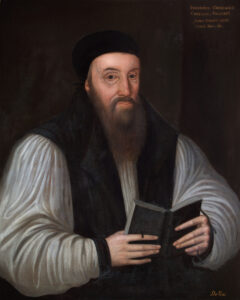
Edmund Grindal, archbishop of York and Canterbury, painting by Dirk Vos or follower, 1580. Held at Lambeth Palace. WikiMedia Commons
MacKenzie’s second period (1575-1582), roughly the primacy of archbishop Edmund Grindal, saw establishment acceptance of Geneva as a royally authorized translation, printed in England by the Queen’s printer, to accommodate Puritan sentiments (chapter five). Beginning in 1575, “the establishment embraced the Geneva Bible” (pg. 111). Even archbishop John Whitgift extensively used it (pg. 113-120) in debates against Puritans. Contrary to conventional understanding, Geneva Bibles in this period were designed and authorized for public worship (pg. 119-126). After 1582, “battles for the Bible” between protestants became muted as conformists and non-conformists stood united, whether holding in hand a Bishops’ or Geneva Bible, against a new enemy, the Catholic Rheims NT (pg. 216).
Geneva Under Archbishop John Whitgift (1583-1603)
MacKenzie only glances beyond 1582, but the landscape in England shifted again the next year. The Articles of archbishop Whitgift on 19 October 1583 provided a catalyst for a third period (1583-1603). In this period, conformists required uniform use of the Bishops’ in public liturgy (in private use and public debate Geneva continued to be authorized) while Puritans used the same requirement as grounds to avoid subscribing to Whitgift’s Articles. Article VI (Bray, pg. 770) sparked decades of dissent, requiring that anyone serving any “ecclesiastical function” must subscribe to three sub-articles:
- “That her majesty, under God, hath…sovereignty…” over all persons of the realm.
- That the BCP, “containeth nothing in it contrary to the Word of God…and that he himself will use the form of the said book prescribed…and none other.”
- That he believes the 39 Articles of religion to be “agreeable to the Word of God.”
Puritans could subscribe to the first and third. The second was the sticking point: the BCP’s direction of church government and worship was their core complaint. Less noticed is Article X: “That one kind of translation of the Bible be only used in public service, as well in churches as chapels, and that to be the same which is now authorized by the consent of the bishops.” (Bray, pg. 771). Whitgift was fine with the Geneva in private reading and public disputation; he sought conformity only in public liturgy (MacKenzie, pg. 126-128). While “Whitgift’s actions represent a modification of previous policy regarding the Geneva Bible, it was in no way a repudiation of this version by the establishment” (pg. 128).
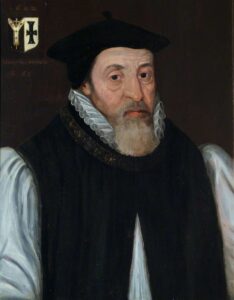
John Whitgift, archbishop of Canterbury, Lambeth Palace, oil on canvass, anonymous, 1602. WikiMedia Commons.
Whitgift’s Article unwittingly played into Puritan hands, creating grounds to reject subscription. The logic seemed airtight: the Bishop’s text and its predecessor (the Great Bible) were required in the BCP. But that text could be shown corrupt by Geneva, authorized for private reading. Subscription accepting the BCP as containing nothing “contrary to the Word of God” would thus endorse corrupt translation. So they could not subscribe.
This brilliant loophole was liberally employed. An example is in order. One of the largest collection of Puritan documents is a manuscript in the Williams Library, The Second Part of a Register. The first part was published here. The second part, intended for publication in the 1590s, never saw the press, though Albert Peel published a calendar in 1915 in two parts: vol. 1 and vol. 2. The manuscript is a treasure trove of Puritan sentiment. On 5 Dec. 1583, Mr. Hely and other ministers met with archbishop Whitgift, who pointedly warned: subscribe or be deprived. Following a series of objections Hely played his trump card: “But my Lord, if we subscribe to [the BCP], do we not subscribe to the translation of the Bible which that book appointeth to be read? And that translation is faulty in many places, yea, and very corrupt” (Peel, 214). In this instance at least it didn’t work. Visitation articles for their provinces a few months later required wardens to check “Whether the Bible used in the parish church or chapel be of the same translation that is allowed by the Bishops” (pg. 220).
Love for Geneva was evident. One Puritan asks if men will “throw aside the Genevan version and the notes attached, which have been so great a blessing?” The Bishops’ Bible is caricatured as “patched together” by men without grasp of the languages. The content itself was not the problem, for even in a Bible rumored to come, the bishops would never allow a single word in any translation to speak against them (Peel, 176). Another Puritan argues that during the whole reign the Geneva Bible “and the annotations thereto have been used by many, and that Beza’s translation of the New Testament [i.e., Tomson’s Geneva], with the valuable notes attached, is very popular,” concluding that “the continued use of these should be allowed.” For him, “restriction to one translation in public worship is unwise.” This was the common Puritan sentiment. For Elizabeth’s whole reign, “use of many translations has not disturbed the unity of the Church, and even the Church of Rome allowed many until the decree of the Council of Trent” (Peel, pg. 185). Another concludes this restriction of diversity of translation would be “harmful to learning” (Peele, pg. 191-192).
Complaints in this third period by Puritans about “corrupt translation” or requests for a new Bible are usually instances of this legal strategy at work. They in reality reflect neither widespread discontent with the Geneva Bible (clear in affectionate Puritan statements) nor any extensive discontent with the text of the Bishops’ Bible in particular. Exaggeration of the Bishops’ Bible’s “corruption” was rather a necessary backdoor by which to escape subscription by pitting Whitgift’s Article VI against his Article X. We will see this same tactic in renewed use when we assess responses to Hampton Court and consider archbishop Bancroft’s canons reasserting Whitgift’s Articles. In the unwitting admission of King James on 16 Jan. 1604 via his assent to Rainolds’ motion for a new Bible, that all prior English Bibles were “corrupt,” Puritans gained royal support for this tactic, and Roman Catholic apologists gained royal support for their long-standing attacks on Protestant Bibles. The allegation had that kind of dynamic power; a dynamic James was painfully unaware of when assenting to Rainolds’ motion. As we will see, in Catholic and Puritan quarters the note that rang out loudest from Hampton Court was not the commissioning of a new English Bible but the attendant admission that all prior ones were “corrupt.” This is ever the bane of revising Protestant Bible translations: how do you justify revision without condemning what came before? How you do inspire confidence in a revision without destroying trust in its predecessor? James was neither the first nor the last to face the complexity of these questions.
Popular Sentiment?
If we were to date the bill by assuming that it reflected widespread opinion, then its date would be clear. Our bill reflects discontent with the “variety of the translations of Bibles” and presents as a solution “one settled vulgar translated from the original;” sentiment common among the establishment in the 1560’s in our first period (1560-1575) but absent from our second (1575-1582) or third period (1583-1603). Notably, the 2-page bill never mentions the Bishops’ Bible. Seeking the Queen’s “immortal fame” via a new Bible without acknowledging the one already authorized would mean suicide for a bill drafted after 1568. Could a prior date explain the silence? The archbishop referred to in the bill would be not John Whitgift, who continued to use the Geneva and never showed any interest in translating, but Matthew Parker, who had a very public interest in biblical translation and a distaste for the Geneva Bible. The bill would then be a clear precursor to the 1568 Bishops’ Bible as a reaction against Geneva. Presuming an act would be drafted only when Parliament was called (the procedure is discussed in Elton pg. 88ff), and narrowing to the relevant parliaments of Elizabeth’s reign (see summary by Graves here), the Parliament of 11 Jan. to 10 April 1563 would be the most likely date for its composition.
What About Hugh Broughton?
On the other hand, what if the bill doesn’t reflect public sentiment but rather the quirky views of a single individual and those in his circle of influence? David Norton interestingly connects the bill to the much later campaign of controversialist Hugh Broughton for a revision of the Geneva Bible and accordingly dates it “probably from late in Elizabeth’s reign” (pg. 81-82). This connection is promising. In this case, the bill could be dated late in Elizabeth’s reign (vindicating the conclusions of Strype and those following him) but would connect specifically to Broughton’s campaign, rather than reflecting any widespread discontent with the Geneva (congruent with the thesis of MacKenzie).
In the next post we take up Norton’s suggestion and flesh it out with careful analysis of Broughton, employing the brilliant work of Kirsten Macfarlane in her dissertation and articles springing from it. I originally intended to date the bill to 1563-7 but am now convinced that it reflects Broughton’s campaign for a new Bible from 1591-1612 and must have been drafted sometime in 1597-1601, either during the ninth parliament of Elizabeth I, 24 Oct. 1597-9 Feb. 1598, or the tenth Parliament of Elizabeth I, 27 Oct.-19 Dec. 1601. The next post will sustain this conclusion, showing direct connection of the draft to Broughton through verbal parallels in his Epistle to the Learned Nobility (unnoticed by Macfarlane) as well as some of his written correspondence, and perhaps suggestively hinting at a previously unnamed patron of Broughton who supported his efforts. Macfarlane’s thesis can then be extended by showing that the influence of Broughton’s campaign reached as far as Parliament, via whoever drafted this bill.
We should not overestimate the influence. The parliamentary copy is stamped “House of Lords,” but it never became an act (for the procedure see Elton pg. 88ff). In fact, it appears never to have even been discussed. An archivist confirms for me in private correspondence that the voluminous journals of Parliament, now studied as part of “one of the most ambitious, authoritative and well-researched projects in British history,” pass it by in total silence. While perhaps a third of all proposed bills failed after a first reading, this draft appears to have never been read at all in either house, Lords or Commons. Perhaps precisely because it reflected the idiosyncratic campaign of Broughton rather than any popular sentiment, the bill disappeared into obscurity shortly after being drafted, another reason it has been neglected in modern studies on the history of the English Bible and on Broughton himself.
To Broughton we now turn in our next post, considering his campaign for a revision of the Geneva Bible as a final potential precursor to the commissioning of the KJB at Hampton Court, after which we can look closely at that commission from sources previously neglected.
Potential Precursors to the KJB – The 1601 Scottish General Assembly
On Monday, 16 Jan. 1604, the King James Bible was commissioned by the royal authority of King James VI and I. Before examining that commission, I decided to explore potential precursors. In 1601 James called the Scottish General Assembly to meet in Burntisland where it commissioned a new Bible. The masterful and greatly missed historian Jenny Wormald concluded that the “origin of the Authorized Version of the Bible lay in [James’] proposal” to the Assembly (pg. 11). Numerous scholars make similar claims (e.g., David Norton, pg. 82-83; David Wright, pg. 208; William Craig, pg. 220ff). Land of birth may determine citizenship, but place of conception is not unimportant to heritage and identity. Was the KJB first conceived in Scotland or England?
Essential Background
Background against which the decision appeared is essential. On 13 March 1543, as the Reformation made its way into Scotland, Parliament allowed liberty to read the English Bible “till the prelates and kirkmen [churchmen] set forth a translation more correct.” By parliamentary act liberty was granted “to every man or woman to read the Scriptures in their own, or the English tongue,” and all contrary acts abolished (Calderwood, pg. 157). The First Book of Discipline, a reform program of the 1560 Parliament, concluded “that every Kirk [church] have the Bible in English” (pg. 184). In 1564 the Genevan Metrical Psalter appended to the Book of Common Order (STC 16577) was authorized by the Kirk, the text that formed “the structure and substance of Scottish worship until the 1640s,” as Alisdair Raffe terms it in a major Oxford Handbook (pg. 321). The Geneva Bible soon became, Ian Torrence argues in an Oxford treatment, “the distinctive biblical artifact of the Scottish Reformation” (pg. 160).
A Geneva text printed by Thomas Bassandyne in Edinburgh in 1579 carried a long dedication to James VI and his Royal Arms on the title page (STC 2125). The General Assembly funded this semi-official Bible by ordering every parish church to pay subscriptions (approved by the Scottish Privy Counsel). Parliament required every wealthy home to have a Bible and Psalm Book (Torrence, pg. 169). The dedication in the Bassandyne Bible by the General Assembly, dated 10 July 1579, connected royal authority to the work, likening James’ wisdom to that of Solomon (a sure path to his favor). I anglicize and modernize: the “setting forth and authorizing of this book chiefly pertains to your charge,” they argued (probably in Robert Pont’s voice: see below). Connecting Scottish and continental Reformation, Marian exiles who landed in Geneva “banished from their country for the Gospel’s cause,” who had “faithfully and learnedly translated this book” out of the original languages, deserved praise in “the commonwealth of them that speak our language.” James was the key player to them (though only 13 at the time and probably lacking any mature opinion as yet) for,
one great part of the honor of advancing this work pertains to you: by whose authority it was of a certain time past ordained that this holy book of God should be set forth and imprinted anew within your own realm, to the end that in every parish Kirk there should be at least one thereof kept: to be called the common book of the Kirk, as a meet ornament for such a place and and a perpetual register of the word of God, the fountain of all true doctrine….we have great occasion both to glorify the goodness of God towards this country and also highly to extol and commend your Highness’ most godly purpose and enterprise.
Printing the Bible in Scotland was difficult and expensive, but Scotland now had an approved English Bible, Psalter, common liturgy, and a king who it was hoped would back each. Not everyone was content. Scottish Reformation had not achieved “the Protestant objective of making the Bible available in the vernacular languages of the people” (Raffe, pg. 319) which marked out continental and English Reformation: a problem even worse among the Highlands, where it remained difficult, even a century after Scotland adopted the Reformation, “for ministers in Gaelic areas to communicate the contents of the Bible” (Raffe, pg. 320) due to even greater linguistic divides. We should not over-press linguistic differences (some linguists considered these different dialects). Still, most identify a distinctly Scottish language (hear beautiful examples here) important to national heritage. The Geneva Bible “was intelligible to Scots speakers” (Raffe, pg. 319) partly because preachers often adapted its language to Middle or Lowland Scots (Raffe, pg. 319; Torrence, pg. 168). The 1543 Parliament may have allowed liberty to read the Bible “in their own, or the English tongue” (Calderwood, pg. 157), but in 1601 half a century had passed, and one of those options remained unavailable.
The General Assembly and its Extant Accounts

Burntisland Parish Church, sometimes called The Kirk of the Bible, chartered 1587, site of the 1601 General Assembly, Wikimedia Commons
The General Assembly, started in 1560, initially met annually. James disliked it, understandably; it authorized his kidnapping and regularly challenged monarchy. His 1584 Black Acts determined it could meet only when called, eventually going two decades without meeting. James called the Assembly to meet in 1601 at Burntisland parish church (see images here, including the ornate pulpit, magistrate’s pew, and stalls from which Assembly members were addressed) which he had ordered built there in 1587 (see the charter at 6:51 here), sometimes known as The Kirk of the Bible. On 16 May 1601, complaint was brought to that Assembly by “sundry of the brethren” about the translation, Psalter, and prayers in the Common Order. Moderated by Robert Wilkie, this Assembly moved to revise the biblical text and Psalter but not the prayers. Plans were never carried through. Four accounts of the motion remain. Two are official records, and two contemporary Scott’s histories:
- Official Records – The Book Of The Universal Kirk (approved 1638)
- David Calderwood’s History of the Kirk (autograph 1627)
- Official Records – Acts and Proceedings of the General Assembly (approved 1838)
- John Spottiswoode’s History of Scotland (first edition 1655)
Book of the Universal Kirk
The earliest official manuscript records, The Book Of The Universal Kirk, were physically seen and approved by the General Assembly in 1638. Alexander Peterkin edited the manuscripts in 1839. I anglicize and modernize from pg. 497-98:
It being intended by sundry of the brethren that there were sundry errors that merit correction in the vulgar translation of the Bible, of the Psalms in meter, as also that there were sundry prayers in the Psalm book which would be altered, in respect they are not convenient for the meantime. In the which heads the Assembly has concluded as follows: first, concerning the translation of the Bible, that every one of the brethren who have the best knowledge in the languages employ their travails in sundry parts of the vulgar translation of the Bible that needs mended, and to confer the same together at the next Assembly. It is not thought good that the prayers already contained in the Psalm Book be altered, but if any brother would have any other prayers added which are meet for the time, ordains the same first to be tried and allowed by the Assembly.
Calderwood’s History of the Kirk
David Calderwood (1575-1650) was an opponent of episcopacy throughout his career. James disapproved and after a confrontation between them in 1617 banished him to Holland where he remained till 1625. His lasting impact was as an unparalleled historian, working for decades on a massive History of the Kirk. The General Assembly authorized an annual pension for him to finish it. The seminal form of this work is a massive cache of disorganized notes, some of which remain at the British Library here.
Out of these he prepared two versions. First is a short digest, later published in 1678 as The True History of the Church of Scotland… (Wing C279; ESTC R16833). Second is three large volumes which he considered his definitive work, completed in 1627 (the autograph remains in the British Library here), posthumously published in eight volumes by the Wodrow Society in the mid-19th century as The History of the Kirk of Scotland. The 1842 edition (pg. 124 here) differs only slightly from the 1678 (pg. 456 here), modernized here:
In the last Session, it was meaned [intended] by sundry of the Brethren, that there were sundry errors in the vulgar translation of the Bible, and of the Psalms in meter, which required correcting; as also that there were sundry prayers in the Psalm Book, that were not convenient for the time. It was therefore concluded, that for the translation of the Bible, every one of the brethren, who had greatest skill in the languages, employ their travails, in sundry parts of the vulgar translation of the Bible, which need to be amended, and to confer the same together at the next Assembly. As for the translation of the Psalms in meter, it was ordained, that the same be revised by Mr. Robert Pont, and that his travails be revised at the next Assembly. It was thought good, that the Prayers already contained in the Psalm Book be not altered nor deleted; but if any brother would have any other prayers, meet for the time, added, let the same be first tried and allowed by the Assembly.
For the Metrical Psalms it was decided “that the same be revised” by Robert Pont (1524-1606) and that “his travails be revised at the next Assembly,” a historically likely element not mentioned in The Book Of The Universal Kirk. Pont was a central figure of the Assembly and occasionally a commissioner (as the following year) or moderator. He worked on a collection of Psalms (published 1565), helped craft the Assembly’s Second Book of Discipline, translated for it the Helvetic Confession, protested the Black Acts, and crafted preliminary material (probably the calendar and preface) for the very 1579 Bassandyne Bible under critique.
The Assembly “decided to begin a correction of the Geneva bible that had been traditionally used in Scotland,” but these plans, Jacobean scholar James Doelman argues, “were diverted by James’ accession in 1603” (pg. 14-15 here). In fact, the accession may not have been the initial cause of neglect. The next Assembly in Nov. 1602 had been charged to reassess the commission and examine revisions by Robert Pont. They passed both in silence, busy responding to Cardinal Bellarmine and establishing visitation articles for local kirks. Pont asked at that meeting to be relieved of his more pressing teaching duties, and the Assembly consented on account of “his great age, and long travails in the Kirk of God” (pg. 1001). If the revision plan was closely tied to Pont, then his disengagement likely halted efforts. The plan breathed its final breath with his in 1606.
Acts and Proceedings of the General Assembly of the Kirk of Scotland
A second official record of the Assembly, the Acts and Proceedings of the General Assembly of the Kirk of Scotland, supplemented the The Book of the Universal Kirk with history specific to General Assembly meetings. Edited by president Thomas Thompson and approved in 1838, the third volume records the meeting, combining elements of the earlier official record and Calderwood’s History (see pg. 970-71 here). Numerous forms of these Acts and Proceedings exist, all containing the same account. As it adds nothing material to the two above, I refer readers to the hyperlink.
Spottiswoode’s History of the Church
John Spottiswoode (1565–1639), made minister of Calder in 1583, was initially sympathetic to Scottish presbyterianism but became a fawning supporter of James VI and prelacy, following him to England for his accession in 1603. James supplied him a Scottish Privy Council seat (1605) and the influential Archbishopric of St. Andrewes (1615). A popular historian, he wrote a history of Scotland’s Kirk, published posthumously in 1655 as The History of the Church of Scotland… (ESTC R17108). I lightly update the 1655 edition (pg. 465 here; an 1847 edition is on pg. 98ff here):
After this a proposition was made for a new translation of the Bible, and the correcting of the Psalms in meter. His Majesty did urge it earnestly, and with many reasons did persuade the undertaking of the work, showing the necessity and the profit of it, and what a glory the performing thereof should bring to this Church. Speaking of the necessity, he did mention sundry escapes [blunders or printing errors] in the common Translation, and made it seen that he was no less conversant in the Scriptures, than they whose profession it was; and when he came to speak of the Psalms, did recite whole verses of the same, showing both the faults of the meter and the discrepance from the text. It was the joy of all that were present to hear it, and bred not little admiration in the whole Assembly, who approving the motion did recommend the translation to such of the brethren as were most skilled in the languages, and revising of the Psalms particularly to Mr. Robert Pont. But nothing was done in the one or the other. Yet did not the King let this his intention fall to the ground, but after his happy coming to the crown of England set the most learned Divines of that Church a-work for the translation of the Bible, which, with great pains and the singular profit of the Church they perfected. The revising of the Psalms he made his own labor, and at such hours as he might spare from the public cares went through a number of them, commending the rest to a faithful and learned servant, who hath therein answered his Majesty’s expectation.
Spottiswoode skims through the request and motion in a single sentence. He then paints a king astounding all present by his scriptural knowledge, equaling professional clergy (that tracks: James loved to impress), and urging this project “earnestly” and offering “many reasons” why it was necessary, profitable, and glorious. James enumerates errors in “the common translation” and recites whole verses of the Psalter, demonstrating complex errors of meter and text extemporaneously. This Solomonic figure elicits “joy” and “admiration” from the whole assembly, then burns the night oil, personally working on the Psalms “at such hours as he might spare from the public cares.” His intention doesn’t “fall to the ground” (language intentionally evoking OT prophetic certainty; 1 Samuel 3:19, etc.), but he steadfastly persists until the KJB is produced, which, to “the singular profit of the church,” his scholars perfect.
The flattery is thick enough to cut with a knife, raising suspicions about the account. Spottiswoode was mostly in France, not Scotland, from 1601-1603, serving as chaplain to the Duke of Lennox, and likely not present for these events. Only his account paints such a fawning picture of James at the meeting. Indeed, only Spottiswoode mentions any involvement by James at all. Only he connects the decision to the KJB, making his account contradictory. If “nothing was done” with either complaint, he is wrong to connect them to the KJB or the work of James on the Psalter; if he is right in these connections, he is wrong that “nothing was done.” The contradiction likely stems from a poor copy-paste; Spottiswoode has not built from scratch. If he held in his hands a 1611 KJB, knowledge that James worked on a Psalter or a copy of the 1631 Psalms of David (STC 2732), record of the meeting, and his own penchant for Jacobean flattery – such inventory would provide all the building blocks needed to conjecture precisely this account. The specific involvement of James could be accurate, though mentioned nowhere else; the details border on hagiography.
The Scottish Psalter of James VI and I
The 1631/6 Psalms of David, Translated by King James (STC 2732) became a flash point of controversy in the Wars of the Three Kingdoms. Doelman traces their reception history (pg. 454-475 here; pg. 135-157 here). Charles I always maintained they were the work of James VI and I, promoting them as such. Contemporaries accepted this; scholars today doubt it. Most think them largely the work of Sir William Alexander (pg. 454). Whatever authorship is determined, James had interest in the Psalter before and after 1601. In 1584 he versified Psalm 104, probably his earliest translation work (STC 14373; pg. 70ff here).
James noted in 1591 (STC 14379) that good reception would hasten production of his paraphrase of Revelation and “such number of the Psalms as I have perfected: and encourage me to the ending out of the rest.” MS Bodl. 165, fol. 58b contains a translation by James of Psalm 101 written before 1603, transcribed by Rait (pg. 53ff), who notes that its “language is Scots” while the 1631 edition “is written in English.” BL Old Royal MS 18B. XVI contains Scottish translations of Psalms 1-7, 9-21, 29, 47, 100, 125, 128, 133, 148 and 150 with the signature J[acobus] D[ominus] R[ex] S[cotia], many in the hand of James. Joseph Mead noted in a 23 April 1625 letter that James had completed fifty (pg. 11-2). Doelman concludes James completed at least 28 Psalms in Scotland which are “completely different” from those published under his name in 1631/6 (pg. 136).
McMillan’s unsurpassed study of the Psalms of James (Vol. 1; Vol. 2) reveals that in the manuscripts from James “the Scottish dialect is plainly marked” (pg. 114), while in the published Psalter, Scots words “have been carefully excluded.” James’ nicht, richt, delicht, upricht, glaid, caffe, lowe (flame), syne (then), and indwellaris all disappear. He concludes the contemporary Psalter “might have had more of a Scottish savor if the British Solomon’s part in it had been greater” (pg. 120). An appendix below provides examples of James’ work. In his eulogy for James, the bishop of Lincoln claimed the project consumed him to his dying breath.
This translation he was in hand with, when God called him to sing Psalms with the angels. He intended to have finished and dedicated it to the only saint of his devotion – the Church of Great Britain and that of Ireland. This work was stayed in the one and thirty Psalm, Blessed is he whose unrighteousness is forgiven, and whose sin is covered.
Spottiswoode crowned Charles I at Holyrood in 1633. Charles elevated him to the position of Lord Chancellor in 1635, part of his ill-fated campaign to force episcopacy and English liturgy, including its Psalter, onto Scotland. His attribution of the 1631 Psalms to his father played a large role in that campaign. Doelman concludes that the “idea of them, rather than their substance, had the larger effect,” and that ironically, “in the 1630s they became the most public and controversial of his works, at a time when his other works faded into the background” (pg. 147).
It is hard to escape the suspicion that Spottiswoode exaggerates James’ involvement in the proposed Burntisland Bible as a piece of Stewart propaganda for Charles I. He was sometimes accused of rewriting history to favor royalism and episcopacy (pg. 107 here). The General Assembly in Glasgow on 4 Dec. 1638 deposed and excommunicated him as a “pretended archbishop” (pg. 14 here). Notably, the General Assembly never added his anecdotes about James and the Burntisland Bible to any of the official records. Perhaps they too were suspicious. We should not ignore the possibility that redaction went the other way: Spottiswoode could present genuine history which a Presbyterian and then parliamentarian impulse decided to remove James from in official sources, just as it might have cut the monarchy out of Scotland altogether. Spottiswoode and Calderwood did occasionally go toe to toe. Though remotely possible, this is unlikely. Norton cites only Spottiswoode when presenting the decision (which he mistakenly dates to 1602) as a direct precursor to the KJB (pg. 82-83), as does Wormald (pg. 11), revealing how easily reliance on a single, later, biased source might mislead even the best of scholars.
Connecting Burntisland to the KJB
The Bible envisioned by the 1601 General Assembly of Burntisland was a Scottish revision of the Geneva Bible; the KJB was an English revision of the 1602 Bishops’ Bible, as Rule 1 demanded (see BL MS Harley 750, fol. 1v, pg. 88 here). The Burntisland Bible would have been in Lowland Scots, like the work of James on the Psalter (the complaint may even have been spurred by lack of a Scottish Bible); the KJB was in the liturgical language of England. Nothing like the “& uith á bouddenit brest dois seame to bold” (see appendix below) of James could have entered the KJB or English liturgy. The Burntisland Bible was commissioned by the General Assembly for approval in the Scottish Kirk; the KJB was commissioned by royal authority as the Bible for public liturgical service in England. The Burntisland Bible disappeared into oblivion; the KJB was carried through an elaborate process to completion. Indeed, the defining feature of Burntisland’s Bible – appropriation of Geneva into Scottish Reformation – was precisely the element James rejected at Hampton Court, declaring the Geneva “the worst of all” Bibles (Barlow pg. 47). Rejection of its copious notes, in turn, was ordered to be the defining feature of the KJB “without any notes.”

Record of Hampton Court decision to print a new Bible, “and that without any notes,” British Library Cotton MS Cleopatra F II, folio 120r. Click thumbnail to enter British Library Digital viewer.
Burntisland’s Bible was not a direct precursor to Hampton Court. Virtually nothing but the presence of James himself connects the two. Jacobean biographer Pauline Croft wisely concludes, in a lecture that first got me thinking about this question, “although many historians have emphasized Burntisland as the origins of the KJV, I think it’s a bit more complicated than that. There is no straight lineal descent” (5:07 here). Ken Fincham, relying on Spottiswoode, cautiously sees Burntisland revealing a James “much invested in biblical translation” (pg. 79 here), explaining his eagerness to assent at Hampton Court, the same cautious connection made by Mordechai Feingold (pg. 1). However, this interest in translation was evidenced long before, after, and apart from Burntisland, in the neglected work of James on the Psalms, his paraphrase of Revelation, and other biblical writings. Burtisland might in fact be evidence of precisely the opposite of such a connection. Raffe suggests (pg. 321 here) that the 1601 Assembly left a bad taste in the mouth of James, which could explain why he “was reluctant simply to impose the [KJB] on the Scottish Church.” Later, “the canons promoted by his more authoritarian son, Charles I, were swept away in the Covenanting revolution.” The result was that the
King James Bible was ‘authorised’ in the Church of Scotland for less than three years. In the 1640s, Dutch-printed Geneva Bibles, which in contrast to English editions lacked the Apocrypha, continued to be imported to Scotland. This did not prevent the King James Bible from gradually superseding its predecessor. But some evidence suggests that Presbyterians were critical of the King James translation. As late as 1695, a minister censured the approach of the translators, ‘alledging that they were a company of men set to please King James’. Unsurprisingly, one of his objections was to the frequent use of the word ‘bishop’, which the minister saw as a deliberate strategy ‘to countenance Episcopacy’.
If Burntisland’s Bible is not a direct precursor to the 1611 KJB, what of other potential precursors? In our next post I take up a second alleged precursor: an undated parliamentary bill calling for a new translation.
Appendix – Psalms from James VI and I
Psalm 133
Taken from BL Old Royal MS 18B. XVI, transcribed by McMillan, pg. 118:
How goode and pleasant thing lo doth appeare,
Accorde amongst thaimeselfis of brethren deare,
Quho dwell together in a godlie love;
It is most like that precious unguent deare,
poured on the heade, syne trikling like a teare,
upon the beard down flowing from above.
At last doun Aaron’s clothis doth softlie move,
quhill to his garments borders low it veare,
and round about thaime runne for his behove
like crystall dew, distilled on Hermon tall,
or balmy drops that does on Sion fall:
for on those men God sends his blessing sure,
the which is life forever to endure.Finis.
Psalm 101
Taken from MS Bodl. 165, fol. 58b, transcribed by Rait, pg. 54-55:
Thy mercy uill I sing & iustice eik,
uith musik uill I prayse Iehoua great,
I uill tak head the richteous path to seik
quhill tyme Thou call me to Thy mercie seat.
still shall I ualke in uprichtnes of soule
uithin my house quhich halloued is to The,
myne eyes upon no uikkid thing shall roule,
for all suche deides I hate & shall thaime flee.All godles men (thay shall) from me depairt,
I uill not knou no euill nor uikked thing,
the toung bakbytes the nichbour in quyet pairt
I uill cutt out & lett it for to spring,
the man that lookis to hie throuch suelling pride,
& uith á bouddenit brest dois seame to bold,
him can I no uayes suffer nor abyde,
sith that myne eies true men on earth beholde.Thay shall sitt doun uith me, as also thay
shall be my seruandis that do ualk aricht,
no craftie man shall duell uith me I say
nor liers shall be stablisht in my sicht,
I uill rut out ilk morning one & all
of uikkid men that on the earth do duell,
and by that meanes lehouas cittie shall
be uoyde of uikked uorkers fals & fell.
Hampton Court – Activities Day 3
Our last two posts (here and here) traced activities of the first two days of the Hampton Court conference. This post overviews the final day and reflects on the conference as a whole.
Hampton Court Day Three – Wednesday, 18 January 1604
The final day happened in two parts. The first session was most important, treating and deciding issues not yet settled. The second session essentially publicized these decisions. The Puritan spokesmen were present only at the second.
Session One

John Whitgift, Archbishop of Canterbury, from a 1602 painting at Lambeth Palace. Wikimedia Commons.
The first session lasted some two hours. The king conferred with the bishops, deans, some of the doctors and knights of the arches, and some lawyers. Archbishop John Whitgift reported on the issues the bishops had been commissioned to resolve (the three the king himself had raised on Saturday, as well as Rainold’s new point about incipets). The king further raised the issues of the rubric in private baptism, the high commission, and the ex officio oath. Bancroft reiterated Whitgift’s 1583 Articles (Bray #38), to which ministers must conform. James approved of requiring subscription.
As the issues were reviewed, James referred them to special sub-committees. Toby Matthew noted that James listed some initial names “whom he thought fittest to be employed” for these committees (pg. 165). Robert Cecil was charged with keeping the official list of decisions and committees. One copy, titled “A Memorial of some principal matters, to be considered of by the Lords of the Privy Council…” is contained in British Library Manuscript Cotton Cleopatra F II, folio 120r-v. It may be viewed in the British Library Digital viewer here. It summarizes ecclesiastical decisions and lists chosen commissioners.
Notable for this blog is the decision “that care be taken that one uniform translation of the Bible be printed and read in the church. And that without any notes” (orthography modernized). At this stage, just as James proposed, the Privy Council was involved and planned to oversee the production of the KJB. This vision would not be carried through. We look at other copies of these recorded decisions in a later post analyzing the sources recording the decision to produce a new translation.

Record of decision to print a new Bible, British Library Cotton MS Cleopatra F II, folio 120r. Click thumbnail to enter British Library Digital viewer.
Session Two
At the second session, the Puritans were called in: not for their input, but to be given orders about what had been decided without it. Toby Matthew recorded that they were required “to receive such order and direction as [James] should be pleased to give” (pg. 164). He “presently signified, what was done, and caused the alterations, or explications before named, to be read unto them” (Barlow pg. 99).
The issue of the marriage vow in the BCP, “with my body, I thee worship,” reappeared. Rainolds objected on day two to this wording, a long-standing Puritan complaint. Only God should be worshiped; current wording idolized wives. James mocked his singleness, quipping that “many a man speaks of Robin Hood who never shot a bow; if you had a good wife yourself, you would think all the honor and worship you could do to her would be well bestowed.” Now it was suggested that the vow be changed to “worship and honor” to soften its sense, a change never made. James now saw “that the exceptions against the communion book were matters of weakness” (Barlow pg. 100).
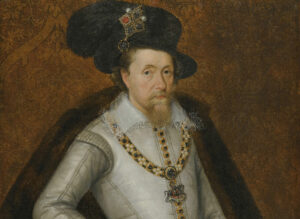
James VI and I, in 1604, wearing the famous “Mirror of Great Britain,” by artist John de Critz. Wikimedia Commons.
Laurence Chadderton begged temporary exception in Lancashire to the requirement of clergy wearing the surplice (see some of the context behind this in our posts here and here). Bancroft protested: if letters of exception were granted Chadderton they would “fly over all England” (Barlow pg. 103). Everyone would ask the same. As if on cue, Knewstubs went down on his knee to ask exemption for Suffolk. James agreed with Bancroft: no exceptions.
According to Barlow, the Puritans “all gave their unanimous assent, taking exception against nothing that was said or done, but promised to perform all duty to the Bishops, as their Reverend fathers” (Barlow pg. 101). Bancroft dropped to his knees again in dramatic fashion proclaiming that “his heart melted within him…with joy” (Barlow pg. 96) at the king’s wisdom. Barlow concludes with a fawning picture of James and exaggerated Puritan acquiescence:
Finally, they jointly promised to be quiet and obedient, now they knew it to be the King’s mind to have it so. His Majesty’s gracious conclusion was so piercing…that it fetched tears from some on both sides. My Lord of London [Bancroft] ended all, in the name of the whole company, with a thanksgiving unto God for his Majesty…[who] departed into the inner Chamber, all the Lord’s presently went to the Council Chamber, to appoint Commissioners, for the several matters before referred (Barlow pg. 99-100).
Not all saw things tied with Barlow’s neat bow. Arnold Hunt’s analysis of Chadderton’s annotated copy of Barlow’s Sum and Substance reveals that Chadderton initially agreed that their duty was “to hear and obey his majesty’s pleasure.” Something about it rubbed him wrong. He crossed out “and obey” (pg. 219 here).
The Third Day Evaluated
All the accounts agree that the third day, “saw the most important issues decided by the King with the advice of his bishops and of his Privy Council, and without any reference to the petitions or the petitioners, except to ask them to promise to accept the conclusions reached without their aid.” (Craig pg. 240). At no point did “equal representatives” of two “sides” meet to debate their differences. The bishops were treated as the legitimate ecclesiastical authorities, advising the king, while the Puritan spokesmen were only allowed to present a dissenting case, itself judged by the king and bishops together. “At no point did representatives for two sides meet in the kind of formal conference that the puritans seem to have wanted, and which Henry Jacob was still calling for two years after Hampton Court” (Craig pg. 240).
The Anti-Puritanism of James and Bancroft
James was clear on how he treated the Puritans. Writing after the second day to Lord Henry Howard, member of his Privy Council, he recounted:
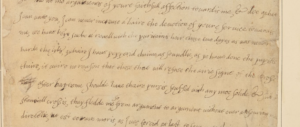
MS. BL. Cotton Vespasian F III Fol. 76r at the British Library – James VI and I To Lord Henry Howard, Jan. 16-18, 1604. Click thumbnail image to enter British Library viewer.
We have kept such a revel with the puritans here these two days as was never heard the like, where I have peppered them as soundly as ye have done the papists there….They fled me so from argument to argument, without ever answering me directly [as is their custom] as I was forced at last to say unto them that if any of them had been in a college disputing with their scholars, if any of their disciples had answered them in that sort, they would have fetched him up in place of a reply, & so should the rod have plyed upon the poor boys buttocks. I have such a book of theirs as may well convert infidels, but it shall never convert me except by turning me more earnestly against them (fol. 76r here, transcribed and lightly modernized; c.f. Akrigg, letter #101).
These words are considered by Curtis to be “in word and tone…filled with hyperbole” (Curtis pg. 12). He thought James friendlier to Puritanism than this. Yet stronger distemper appears in letters to Whitgift, his council, and Robert Cecil (Akrigg #98, #102, #118) and in a series of royal proclamations (Larkin/Hughes #35, #30, #41). James excoriated Scottish presbyterianism as “Puritanism” in Basilikon Doron (written for his son Henry) in “sharp and bitter words.” The manuscript, written in his own hand in 1598 in Middle Scotts, kept at the British Library, may be viewed here. He admonished Henry to “take heed” to “such puritans” who were “very pests in the Kirk [church] and common-wealth of Scotland; whom by long experience I have found no deserts can abolish, oaths nor promises bind, breathing nothing but sedition & calumnies, aspiring without measure, railing without reason, and making their own imaginations without any warrant of the word the square of their conscience” (modernized from f. 12r-v here).
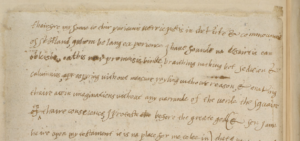
Basilikon Doron (The Royal Gift), from British Library Royal MS 18 B XV folio 12v. Click thumbnail image to enter British Library digital viewer.
A revised edition appeared in English in 1603, part of aspirations to the English throne, becoming a bestseller among a nation curious about the king. James backpedaled, claiming his earlier angry words about Puritanism narrowly described an anabaptist sect, “the Family of Love” (see Sommerville pg. 5-7 here), rather than the English movement. Fear of problems English Puritanism might cause his accession birthed the disingenuous claim. James concluded the fear unwarranted after the conference. His son Charles I later found Puritanism a stronger force than either ever anticipated.
James put a fine point on it in a speech to parliament on 19 March 1604. He found on his accesion three groups “lurking within the bowels” of England: 1) conformist protestantism, which he professed, and which was “by the law maintained”; 2) Roman Catholicism, “another sort of Religion”; and, 3) Puritanism, “a private sect”:
The first is the true Religion, which by me is professed, and by the Law is established. The second is the falsely called Catholics, but truly, Papists. The third, which I call a sect rather then Religion, is the Puritans and Novelists, who do not so far differ from us in points of Religion as in their confused form of Policy and Parity, being ever discontented with the present government, and impatient to suffer any superiority, which maketh their sect unable to be suffered in any well-governed Commonwealth. But as for my course toward them, I remit it to my Proclamations made upon that Subject.
(Lightly anglicized and modernized from Sommerville, pg. 138; for the proclamations referred to see Larkin/Hughes #35, #30, #41.)
English Puritanism’s identification with Scottish presbyterianism earned international audience in 1609 when James attached a massive Premonition to the European rulers to a copy of his Apology for the Oath, which he now owned authorship of, during the long controversy with Cardinal Bellarmine. (James Montague claimed in 1616 that Lancelot Andrewes wrote the Apology, based on notes from James, pg. 35 in the 1616 Works). James defended his words in Basilikon Doron, spoken “ten times more bitterly of them nor of the Papists; having in my second edition thereof affixed a long Apologetic Preface, only in odium Puritanorumi” (pg. 44-47 here). Alan Cromartie rightly concludes that “the evidence suggests that James was in practice more hostile to puritan dissent than even the most authoritarian bishops” (pg. 62).
Bancroft’s disapproval, known from Anti-Puritan writings and actions before the conference (see Collinson here) reappear in the canons drafted in its wake. Convocation passed these in 1604, turning conference decisions into law. They demanded sharp conformity to the new edition of the BCP, its government, and liturgy, remaining in force until 1969 (Bray #8).
Interpreting the Conference – Embittered Battle or Round Table?
Ken Fincham remarks of the conference that “the event and its wider outcomes continue to be debated by modern historians.” Classic treatments (Cardwell, Strype, Gardiner, Usher, etc.) remain helpful. The claims of Mark Curtis (and advances in historical methodology) sparked modern reassessments from diverse angles. Some major ones include:
- Mark Curtis, influentially and mistakenly reviving a Puritan-friendly picture in 1961,
- S.B. Babbage in a half-hearted appraisal of Bancroft’s Anti-Puritanism in 1962,
- B.W. Quintrell, pressing the vexing question of deprivations after Hampton Court in 1980,
- Frederick Shriver, rightly correcting Curtis, in 1982,
- Peter Lake in his moderation of Puritanism in 1982,
- Collinson, responsively reassessing the treatment in his thesis, in 1983,
- Ken Fincham, from the perspective of diocesan response in 1985,
- Fincham and Lake together, in broader assessment of royal ecclesiastical policy, in 1985,
- Nicholas Tyake, refocusing English dispute on Arminianism, in 1987 (pg. 9ff. here),
- Peter White, with tenuous and almost opposite conclusions, in 1992 (pg. 140-152),
- Arnold Hunt, examining Chadderton’s annotations to Barlow, in 1998 (pg. 207-228 here),
- W.B. Patterson, reimagining James as global peacemaker, in 1997 (pg. 31-74 here),
- Lorie Anne Ferrell through the lens of polemical rhetoric here in 1998,
- Robert Oliver in a paper briefly overviewing the conference in 2004,
- Diana Newton, reevaluating James’ initial English reign based on her Phd work, in 2005,
- Alan Cromartie, painting an essentially Laudian James, in 2006,
- Colin Buchanan, in a helpful edition of the main documents, with analysis, in 2009,
- A. Kenneth Curtis, in a chapter celebrating the KJB’s quatercentenary, in 2009,
- Bernard Bourdin, analyzing the Oath of Allegiance controversy, (pg. 96 ff), in 2010,
- Bracy Hill, analyzing 18th century historiography of Hampton Court and the KJB in 2011,
- Collinson a final time, in a reassessment of Bancroft and Anti-Puritanism, in 2011,
- Ferrell again, splitting private and liturgical Bible reading, in 2015 (pg. 261-271 here).
- Joshua Rodda, along the way in focused reassessment of scholarly disputation, in 2016,
- John Morgan, through the lens of Henry Jacob’s “reason-of-state” language, in 2017,
- Ken Fincham again, for the official ODNB entry on the conference, in 2018,
- John Morgan again, seeing Jacobean policy as an act of fervent anti-popularity, in 2018.
This is to say nothing of the spate of books on the KJB (e.g., Norton, McGrath, Nicolson, Opfell); English Bible history (Daniell, etc.); biographies of James (Stewart, Croft, Wormald, Willson, Lee, etc.); or British histories, which all typically treat the conference. Craig’s PhD work from 2007 remains the most thorough analysis to date and should have completely settled long-standing debates. Instead it has been completely ignored, save a small journal article summarizing a single chapter. Cromartie employed similar methodology on a smaller scale, and his thesis is immensely strengthened by the work of Craig. No one has cared to notice.
The widely influential thesis of Mark Curtis that the reactions of the Puritans to the conference were “on the whole favorable,” that the conference was only looked upon as a “failure” because in its “aftermath” the state didn’t make good, and that “the worsening of factional struggles within the church” resulted not from any disparate treatment of the Puritans at the conference but from a later negligence to carry out Hampton Court’s decisions, need to be finally laid to rest in their grave. Whatever Hampton Court was, it was not an even hearing of two sides, nor any fair battle between them. In his magisterial thesis on Puritanism in 1957, popularized in 1967, Patrick Collinson wisely urged avoiding such romanticizing. Puritan and conformist voices existed on a spectrum without a unified voice. Further,
Such decisions as were made at Hampton Court were more indicative of a round-table conference than of the disputations which changed the faith of other parts of Europe in the years of the Reformation. Some of the matters on which the king agreed to act were not at all controversial in their nature…Others were, in effect, neutralized by royal orders made at or after the conference, notably the authorization of a new English Bible (pg. 459 here).
While the “two-party description of Hampton Court” finds precedent in contemporary accounts (Craig pg. 256), close examination renders it wrongheaded. Even if “the conception of the conference began as a meeting of two sides presided over by the King, it became a brief meeting of one side with a King who was supported by the other side” (Craig pg. 268-269). If James intended to be an impartial moderator, “he did not confine himself to that role very long” (Craig pg. 268). Craig’s thesis strengthens and lightly modifies Collinson’s conclusion that the conference “did the puritan cause positive harm.” It was now crystal clear “that James was as hostile to the very principles of dissent and nonconformity as ever Elizabeth had been” (Collinson, pg. 461).
Debate remains about who chose the Puritan spokesmen and how well they represented Puritan interests (see Morgan here, analyzing the complaints of Henry Jacob). Yet the evidence sweeps away any doubt that the Puritans were snubbed. This was “the king’s own conference” as Craig termed it in the title of his dissertation. It was a “round-table” not in that all parties had equal audience with the king, but in that James was fully in charge and invited members to the table to play roles he dictated. The presence and arguments of the four Puritan spokesman, far from driving the conference as usually thought, made virtually no difference to its decisions in the end. Dissenting clergy weren’t included in any major decisions or even discussions. James “allowed four ministers, who were probably not chosen by the larger body of puritans, to present their case at one session of the conference, but all in all, if the meeting with the four ministers had not taken place, the outcome of the conference at Hampton Court would not have been much different” (Craig pg. 271).
The Request for a New Translation
This brings us to the point at which we can finally look more closely at the request by Rainolds for a new translation with a full historical context for understanding it. Information from the diverse accounts which Craig highlighted has often been ignored in treatments of Hampton Court focusing on the KJB which rely narrowly on Barlow’s account, perhaps with brief notes from one or another additional accounts. An imperfect image of the request for a new translation has resulted. What motivated this request? Was it planned ahead of time or was it a spur of the moment decision? What was Reynolds really seeking? Was the request sincere? Why did James to agree to it? These questions and more we take up in our next post, as we compare all the extant accounts of this motion for a new translation and propose a fresh interpretation of the request.
Posts On The Hampton Court Conference
Hampton Court – Activities Day 2
In our last post we traced the activities of the first day of the Hampton Court Conference. In this post we overview the events of the second day, on which a new translation was first proposed. In the next we will overview the third day.
Hampton Court Day Two – Monday, 16 January 1604
On Monday, the Puritans finally got their long awaited audience with the king. Archbishop Whitgift and the other bishops had been charged to settle by Wednesday the issues commissioned to them by the king. They thus met in a separate Council Chamber while the king heard Puritan complaints. Whitgift sent two bishops as delegates representing conformity to the Puritan meeting with the king in the Privy Chamber: Richard Bancroft and Thomas Bilson. Both would go on to shape the KJB.
When the Puritan spokesmen were called in sometime between 11:00 and noon they found the men (minus the deans and doctors) already discussing matters among themselves. The deans and doctors joined them. Young prince Henry was sitting on a stool to the side, a month before his tenth birthday, probably quite bored by the events he was supposed to be observing. The king’s special chair was placed centrally as before, and when he entered, the day officially began.
James made a brief speech, determining “not to innovate the government presently established,” which had been blessed by God for forty-five years, so that “no Church upon the face of the earth more flourished” than England’s (Barlow pg. 22). He dictated his three purposes for the conference to the Puritans:
- To settle a uniform order through the whole church
- To plant unity for the suppressing of Papists and enemies to Religion
- To amend abuse
James explained that “many grievous complaints” had come since his accession and he was ready to hear from them “what they could object or say” (Barlow pg. 22-23). The Puritans set the rest of the agenda for the day.
The Puritan Spokesmen and their Complaints

John Rainolds (1549-1607) ©Corpus Christi College, Oxford, UK. Wikimedia Commons.
The four men who had been chosen were Dr. John Rainolds, President of Corpus Christi College, Oxford; Laurance Chadderton, Master of Emmanuel College, Cambridge; John Knewstubs, Rector of Cockfield, Suffolk; and Dr. Thomas Sparke, Rector of Bletchley, Buckinghamshire. James had sent for those who he thought to be “the most…modest of the aggrieved” (pg. 22-23) as opposed to the more radical Puritan spirits. Who precisely chose them, how, and why, remain debated questions. They likely were chosen for being so moderate as to barely represent Puritan interests. They posed no substantive challenge to conformity. “Spokesmen,” we noted before, is a more accurate term than “delegates” or “representatives.” Puritans of the hotter sort (Henry Jacobs most vocally) later claimed they weren’t represented at the conference. In any case, Rainolds served as their voice. He laid out a four point agenda (Barlow pg. 23-24):
- Doctrine
- Ministry
- Church government/discipline
- Subscription
He apparently treated the third heading last in discussion, perhaps seeing #2 as naturally leading to #4. Or perhaps delaying the most contentious. Below are his complaints as he expressed them, following Barlow generally. Remember that his accuracy is solid in broad strokes but not always small details. He may be inaccurate in the order in which complaints were raised. Other accounts have a slightly different order. Links go to the appropriate page in Barlow unless otherwise indicated.
- That the Doctrine of the Church might be preserved in purity (Doctrine)
- The Articles of Religion need explained where obscure and enlarged where defective (Barlow 24-30; Usher 336; Usher 344)
- The catechism too brief (pg. 44)
- Reformation of the Sabbath Day desired (pg. 45)
- A new translation of the Bible desired (pg. 46-48; Usher 345)
- Unlawful and seditious books need banned (pg. 49; Usher 346)
- That good Pastors might be planted in all Churches (ministry, pg. 52-57; Usher 346)
- The ministry to be resident
- The ministry to be learned
- That the book of Common prayer might be fitted to more increase of piety (subscription) Their objections to subscription were as follows:
- Apocrypha (pg. 60-64; Usher 336; Usher 347)
- Incipits – (adding phrases like “Jesus said to the disciples” to introduce scripture readings in the liturgy – pg. 64)
- Interrogatories put to infants in baptism (pg. 64)
- The sign of the cross in baptism (raised by Knewstubs, pg. 67-76; Usher 349-50)
- The surplice (pg. 76-77; Usher 348)
- The word “worship” in the marriage vows (pg. 77)
- The ring in marriage (pg. 78)
- Churching of women (pg. 78)
- The Ex Officio Oath (Usher pg. 351)
- That Church government might be sincerely ministered (discipline)
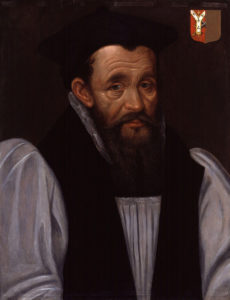
Richard Bancroft, bishop of London, soon to become Archbishop of Canterbury, was one of two bishops representing conformity on day 2. He became the chief overseer of the KJB. Wikimedia Commons.
Rainolds was constantly interrupted by Bancroft, Bilson, and occasionally the king himself, who at one crucial point where Rainolds had the misfortune to mention “presbytery” took him to mean the Scottish presbytery that had caused such trouble in his homeland, which, “as well agreeth with a Monarchy, as God, and the Devil” (Barlow pg. 81). Jenny Wormald softens the king’s temper, remarking that “in the heat of debate, he was surely seeing not John Rainolds and his associates, moderate men all, but in response to Rainolds’ unlucky use of the word ‘presbytery’, seeing Andrew Melville and his extremist supporters.” Collinson suggests James may have been disingenuous. Whether Rainolds was referring to a Scottish presbytery or James actually thought as much didn’t matter: pretending that he was gave him the opportunity to assert the divine right of his monarchy. A long speech in a rebuking tone followed. “When I mean to live under a presbytery, I will go into Scotland again. But while I am in England, I will have Bishops,” James retorted (Usher pg. 351). At least twice James interjected the aphorism, “no Bishop, no king” (pg. 36, 84), warning that to threaten episcopacy was to threaten his monarchy.
Bancroft and Bilson made regular shows of conformity, bowing before the king or arguing for a “praying” against a “preaching” ministry. In these “fighting words” Lorie Anne Ferrell detects an attempt (pg. 142) to paint the Puritan spokesmen as aligned with treason. Bancroft muttered that these men the night before had “made a semblance” of joining the bishops and fighting for “nothing but unity” in the church yet now strike to “overthrow” it (Barlow pg. 26-27). Kneeling again, he begged his majesty to remember the canon that schismatics should not be heard against bishops. As Harley MS 828 puts it, Bancroft cast them into the extremist’s camp of Cartwright, adding with insult that, “they greatly abused his Majesty’s patience” by approaching him “in their Turkey gowns, more likely to conform themselves to Turks, than to the order of our Church.” The account claims unfoundedly that “Thomas Cartwright had taught them” this, “whose scholars they shewed themselves to be.”

Thomas Bilson, Bishop of Winchester, one of two bishops representing conformity on day 2, would later go on to serve as one of the final editors of the KJB, probably crafting the chapter summaries and possibly the dedication to King James. Wikimedia Commons.
We noted in our last post Carleton’s comment that the two companies differed in opinions as in fashions, one marching “in gowns and rochets and the other in cloaks and nightcaps.” This was the “vestments controversy” of the 1560’s re-enacted, the spicy insult of “turkey gowns” describing simple robes rather than priestly vestments, starkly out of place in the royal court. Rainolds defended them by claiming that in the universities they wore required gowns, “but abroad they might use such fashion of gown” as fit their calling. Bilson and Bancroft grumbled. “They should have worn priests gowns with tippets, and not these trunk gowns,” they retorted, adding that they might be legally punished for their offense. James lightheartedly admonished Bancroft, “My Lord, you are too hot in the beginning, and within a while after, now my Lord, you are more charitable” (Harley MS 828, in Usher Vol. II pg. 344). Of course, Barlow’s second Puritan account suggests that “the bishop of London behaved himself insolently” here (Barlow). “There was much stir about all the ceremonies and every point in it,” Dr. James Montague recorded. “They argued this point very long.”
An Example Discussion – The Apocrypha in Church and Bible
Each of the above points merits explanation, but this would take us afield of our purpose. Since we raised briefly in our treatment of the Millenary Petition the regular Puritan complaint that the Apocrypha was being printed in the Bible and read in the liturgy, we can examine some of the discussion on this point here as an example of how events can be pieced together from diverse accounts. Rainolds took occasion to “leap into” discussion of subscription (pg. 60). The Puritans would conform to a limited subscription, assenting to the 39 Articles and the Supremacy of James over the church, the first and third of Whitgift’s 1583 Articles (Bray 38). But the second article required affirming that the BCP contains “nothing in it contrary to the word of God” and that “he himself will use the form of the said book prescribed, in public prayer and administration of the sacraments, and none other.” This they could not do. Their first objection to subscription was “the books Apocryphal” which the BCP “enjoined to be read in the Church.” In them were “manifest errors, directly repugnant to the scriptures.”
Examples of Errors in the Apocrypha
Rainolds was ready with an example: Ecclesiasticus or Wisdom of Sirach 48:10, which he read as prophesying that Elias himself would come. Malachi 4:5 prophesied a coming of Elias that the NT saw as fulfilled in John the Baptist as forerunner of the Christ (Luke 1:17; Matt. 11:14). The text in Sirach implied that Christ and his coming did not fulfill prophecy. This then “implied a denial of the chief Article of our redemption.” It is strange that this is the example Rainolds chose, perhaps not so much that it was the one Barlow recorded. Rainolds had stronger examples to offer. In his special lectureship at Oxford beginning in 1585 he had delivered 250 lectures against the Catholic Bellarmine’s counting the Apocrypha as part of the canonical OT, Feingold explains, illustrating his arguments here. These were published posthumously in 1611. “After that many lectures,” Gordon Campbell quips, “any listener who was still awake would surely be convinced.”
Bancroft was not. He jumped up in rebuttal: such objection was nothing new, having been made for centuries by the Jewish apologists. These were books of antiquity, long in use by the Church. At this Thomas Bilson, bishop of Winchester, the other conformist representative, piled on. These books had been long accepted, as seen in the distinction allegedly from Jerome that these books weren’t part of the canon read to establish doctrine, but they were read [in the church] for instruction of manners, a distinction essential to reading of church councils (Barlow pg. 62).

James I, in 1604, wearing the famous “Mirror of Great Britain,” by artist John de Critz. Now at Montacute House. Wikimedia Commons.
James interrupted, concluding that he would “take an even order between both.” This was the typical Jacobean stance. He technically didn’t wish even all the canonical books read in the church, unless interpretation were given (which it usually wasn’t in the liturgy), nor any apocryphal book “wherein there was any error.” The distinction encouraged liturgical reading of the other Apocrypha, “which were clear, and correspondent to the Scriptures.” Of these James concluded, “he would have them read [in the liturgy of the church]” or else, James asked, “why were they printed [in the Bible]?” (pg. 62). He provided example of their profit in the church service by reading from the Book of Maccabees, which helps fill in the story of the persecution of the Jews, but isn’t sufficient to establish doctrines like sacrifice for the dead.
James Montague summarized: it was concluded that “nothing of the Apocrypha to be read that is in any part repugnant to the Scripture; but to be still read, yet as Apocrypha, and not as Scripture.” In the first of Usher’s anonymous accounts (CUL MS M.m.1.45) the summary is given, “For the Apocrypha, he [James] allowed and justified the use thereof” (Usher Vol. II pg. 336). Harley MS 828 gives a slightly different picture. “The King said he saw no reason but that they might be read [for instruction of manners] though not [for the edification of faith], as of ancient time hath been done in the Church.” When Rainolds alleged numerous errors “contrary to the Canonical Scriptures,” giving one or two examples, James “very learnedly argued,” and then conceded that “all such parts as had errors should be taken out, and others of them more sound read, which may best seem for explanation of the Scripture and instruction to good life.” Rainolds was charged to make a full list of these alleged errors. Perhaps 250 lectures should have produced one already.
Whitgift and Sparke

John Whitgift (c. 1530-1604), Archbishop of Canterbury. Oil on Canvas at Lambeth Palace. Artist unknown. Wikimedia Commons.
Rainolds was fortunate that Archbishop Whitgift was not in the Privy Chamber. Walter Travers recorded a conference in the 1580s between himself, Sparke, bishop Cooper, and Archbishop Whitgift, over Puritan complaints to the BCP, possibly caricaturing Whitgift (item 173 in Peel, modernized and lightly summarized below). When Whitgift asked for complaints, Sparke launched into prayer, only to be interrupted impatiently and ordered to spill it. (He squeezed in a short prayer anyway before he could be stopped.) The first complaint was about “the books appointed to be read in the Church for holy Scripture.” He divided “canonical and apocryphal.” The BCP problematically never scheduled readings from some parts of the OT, technically making it illegal to read them in Church. Adding fuel to fire, it regularly required readings from the Apocrypha, intimating that these had greater value than some of the OT.
Whitgift: “The books called Apocrypha are indeed parts of the Holy Scripture and of the Old Testament, they have been used to be read in the Church in ancient time, and they might and ought to be now read amongst us.”
Travers: Holy Scripture is a title reserved for the canon of the OT and NT, only applicable to books inspired by the Holy Spirit.
Whitgift: “The Apocrypha were likewise given by inspiration from God.”
Travers: Surely this could only be true in the general sense in which anyone saying “Christ is Lord” is inspired, not in the sense of producing a writing without error.
Whitgift: “You cannot show any error to be in the Apocrypha. They have bene held for Holy Scriptures by the ancient fathers, and so vouched and cited by them, as namely by Cyprian and by Augustine and divers other from the beginning of Christ’s Church, so always esteemed, and therefore read in the Church unto this day.”
Travers: Jerome distinguished between canonical and ecclesiastical books.
Whitgift, wearily: This “doubting of the Scriptures is a dangerous way for atheism to enter in by among us.”
Sparke Looks Back at Hampton Court
Now, debate continued in the Privy Chamber without Whitgift’s conservative voice. Sparke on this occasion was entirely silent. According to Anthony Wood in 1691, “he spoke not one word.” Whatever fire once burned in Sparke for the subject had since gone out. He was likely already a conformist, or on his way to it. In his 1607 recollection of Hampton Court he argues that he had always conformed (a document we look more closely at in a later post). He recounts the debate on this day in his preamble, referencing Barlow. “His Majesty’s order was, that none of the Apocrypha should be read at all, wherein there was any error. And therefore his highness willed Dr. Rainolds to note those chapters in the Apocrypha books, wherein such errors were, and to bring the note thereof to the Bishops.” He recounts Barlow suggesting that the preface to the second Book of Homilies (a major formulary of the Church of England, which the 39 Articles required assenting to and preaching annually) allows ministers to replace a prescribed OT reading with a NT one. It is doubtful such moderation truly came from Barlow. In any case, ingeniously, he suggests a compromise wherein a scheduled reading from the Apocrypha could be replaced by a NT reading at the minister’s discretion. He takes an entire chapter (chapter 10) to elaborate this compromise solution, arguing that conformity should thus be acceptable to the Puritans. It would never have worked. It required acknowledging the Apocrypha as part of the “Old Testament” which was precisely what the Puritans were unwilling to do. More important is his portrait of James and his view of the complaints, who “most wisely foreseeing” that even if concession was made to each,
it was likely enough that some things in the book, or within the compass of the urged subscription, would still seem unto some so harshly to remain set down, as that they would stick and stay thereat. His Highness most graciously signified unto us, that as it was our duty, so he wished every one of us, to construe and take everything in the best sense that we could, and not in the hardest and worst: for so only his intent and pleasure was, that they should be urged.
In the actual revised version of the BCP published later that year, only four minor changes to apocryphal readings were made (replaced Bel and the Dragon with Prov. 30, Aug. 26; Tobit 5,6 with Exodus 6, Joshua 20, 1 Oct.; Tobit 8 with Joshua 22, 2 Oct.) as detailed in the letter of James to Archbishop Whitgift on 09 Feb., 1604, (printed in Cardwell, pg. 221-22). Not the great victory for Rainolds that some have seen. As Ariel Hessayon points out, about 104 of 172 chapters of the Apocrypha continued to be read publicly in the liturgy of the church, compared with only 592 of 779 chapters of the canonical Old Testament.
Aftermath

Start of the Apocrypha in the 1611 KJB. Absent is a dedicated title page. Typical running subject headings all say generally “Apocrypha” throughout each of the books. The title page of the KJB omits mention of Apocrypha, and the Table of Contents sandwiches them between canonical books without mention in the heading. Image credit Villanova University.
After James, Bancroft, and Bilson had all ganged up on Rainolds, James got out of his chair and retired briefly into his inner chamber, at which point heated discussion about the text in Ecclesiasticus continued among the lords (pg. 63). Such debates were perennial. Petitions like the Millenary Petition had expressed Puritan discontent with the role of the Apocrypha in the Church of England for some time. Scores of other examples could be listed. The 1611 KJB and its printing of the Apocrypha, we have before explained, comprise a sort of snapshot of this moment in history, when different forces were pulling in opposite directions. This moment is frozen for us in time in the KJB itself, which reaches neither the position of The Council of Trent and their Decrees on the Apocrypha nor the Confession of Faith of The Westminster Assembly. It rests instead somewhere ambiguously between these two bodies and their declarations, with a sort of “quasi-canonical” status that is complex, nuanced, and difficult to capture in simple terms.
The Day Ends
Craig explains the uniqueness of this day. It was “the only part of the conference which seems to have been anything like a disputation between two sides, since the puritans did not take part on Saturday and on Wednesday they were only to be called in to hear and accept what the King had concluded.” Indeed, he concludes, “with a different group of participants, and an opening speech by the King similar to that on Saturday, this session almost seems like a new conference” (Craig. pg. 265).
The day ended around 4:00 pm. “They had a cold pull of it and are utterly foiled,” Usher’s first anonymous account concludes, as the “triumph” they had long fought for. “Dr. Rainolds and his brethren are utterly condemned for silly men” (Usher Vol. II pg. 337). Oliver Ormerod, in his 1605 “The Picture of a Puritan” casts the Puritan spokesmen into the radical reformation borrowing language from the royal proclamation of 5 March 1604. As men “conformable to the state of the Church” gathered to hear “those which dissented,” the conference disappointed in its effects. James found the complaints “supported with so weak and slender proofs” that he and the Privy Council concluded that there was no reason why any changes at all should be made “in that which was most impugned, the Book of Common prayer” (BCP), nor in the doctrines, rites, or forms, of the church. James got out of his chair, and left for his inner chamber. As he did, he was heard muttering: “If this be all that they have to say, I shall make them conform themselves, or I will harry them out of the land, or else do worse.” Robert Cecil thanked God for giving them a king with such an “understanding heart.” Craig summarizes:
… the King conceded almost nothing of importance at the second session. The King and bishops had already dealt with the issue about ministry that Rainolds raised, as well as lay baptism and confirmation. The noxious ceremonies, on which their instructions had laid so much stress, remained, even though they had made the most moderate arguments against them. Aside from the plan for a new translation of the Bible the puritans won some additions to the catechism, an amendment of two sentences in the Sunday gospels, the removal of a few readings from the apocrypha, and the possibility that it might be considered whether a word, the wrong word at that, might be added to Article 16. It never was. The four were to come back on Wednesday and hear what the real conference had decided.
– Craig pg. 235-236
We come in our next post to the third and final day of the conference.
Posts On The Hampton Court Conference
Hampton Court – Activities Day 1
In our last several posts we have examined the avenue, attendees, and accounts of the Hampton Court conference. In a future post we will zoom in on the request made at the conference for a new translation which resulted in our King James Bible. To place that request in historical and political context, a clear overview of the events of the entire conference is first needed. To that end, this post and the next two will each overview one day of the conference.
The Activities – Historical Difficulties
Patrick Collinson, that veteran scholar of Puritanism, cautions that “the historian of Hampton Court faces formidable difficulties” (pg. 36 here). I have repeatedly found his dictum true while sifting through partial and contradictory accounts. Revisionist interpretations of Hampton Court and the larger political and religious currents it symbolized bequeath fresh difficulties to a modern historian. Collinson earlier cautioned that “the Hampton Court conference and its outcome are not to be over-simplified, still less to be over-dramatized” (pg. 459 here). At the risk of over-simplifying, can the events of the conference be briefly summarized? This and the next two posts make a humble attempt.
The Pre-Conference Meeting – Thursday, 12 January 1604
On Thursday morning, archbishop John Whitgift, with bishops Richard Bancroft of London, Toby Matthew of Durham (made archbishop of York two years later), Thomas Bilson of Winchester, Gervase Babington of Worcester, Anthony Rudd of St. David’s, Anthony Watson of Chichester, and Henry Robinson of Carlisle all gathered in the king’s Privy Chamber for the start of the conference. As we have noted before, the date had been mistaken. They did not yet know this with certainty (though it is possible they had heard rumors) so they gathered and waited.
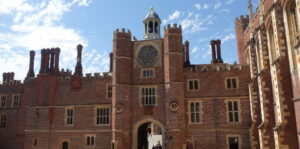
The Astronomical Clock as viewed from the rooms in which the Hampton Court Conference was held. Photo Credit – Hannah Berg
They were eventually called by the king into his private Withdrawing Chamber. Matthew might have glanced out the window, across the court at the great astronomical clock, or simply heard its chime. In any case, he noted that it was 9:00 am when they were called out of the Privy Chamber. The king explained that the day had been mistaken but also gave the bishops an explanation of what the conference would entail.
Patrick Galloway, the Scotsman who had accompanied James to England, explained that the bishops were asked “to advise upon all the corruptions of this church, in doctrines, ceremonies, and discipline; and as they will answer to God in conscience, and to his majesty upon obedience, that they should return the third day after, which was Saturday.” He clocked the meeting at five hours and mistakenly counted it as the first day of the conference. Bishop Matthew recounted that they were brought into the king’s private inner Withdrawing Chamber:
Where, in a very private manner, and in as few words, but with most gracious countenance, he [the king] imparted to us, first, the cause wherefore we were called up; which was, for the reformation of some things amiss in ecclesiastical matters, supposed, and by some complained of….Lastly, his majesty gave us to understand, that the day was somewhat mistaken, being meant by him to be the Saturday after; at which time his majesty willed us to repair at the court again.
The significance of this intimate “pre-conference meeting” should not be underestimated. The bishops were given personal and private audience with the king in the most secretive and protected part of his palace (apart from his Privy Lodgings, where he never entertained visitors). When the conference proper started Saturday, the bishops already knew the king’s agenda. They had, in a way, foreseen the direction of the conference before it began.
Day One – Saturday, 14 January 1604
On Saturday the Privy Council, deans, and doctors made their way through the Great Hall to the great Watching Chamber and through the small doorway in the corner of the room into the King’s Presence Chamber. They found the four Puritan speakers already there, “sitting upon a form” or inelegant wooden bench (Barlow pg. 2), apparently unaware that the plans for the conference had changed and that they would not be part of this day’s proceedings. The king called the bishops at 11:00 am into his personal Privy Chamber.
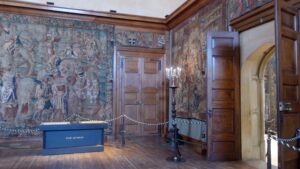
The Great Hall (through the doors to the right) leads into the Watching Chamber (where the photographer is standing). From the Watching Chamber, through the small doors pictured on the left (now closed to the public), one would enter the king’s Presence Chamber. Photo Credit – Hannah Berg
The Puritans were left in the Presence Chamber, separate from the proceedings entirely. At the end of the day, the Lord Chancellor called for them to inform them to return Monday. Disappointment must have crossed their faces as they were shuffled around and then summarily dismissed, never even reaching the Privy Chamber, the king’s inner sanctum.
The bishops, on the other hand, went straight into the Privy Chamber. While waiting, commandment came from the king that only the Privy Council, the Bishops, and five of the deans (Royal Chapel, Westminster, Paul’s, Chester/Westchester, Salisbury) were allowed in. When they were all called in, the Lord Chamberlain shut the door. The king entered from his Privy Lodgings and his special chair was pulled out for him from beneath the canopy of state and placed in the center of the room (Thurley pg. 108). The Privy Council was seated on his right, the bishops on his left. James entered and sat.
The conference began.
James opened with an hour-long speech. He explained that, contrary to a century of English monarchs for whom change seemed the only constant, he saw no reason to “alter and change anything,” choosing rather “to confirm that which he found well settled already.” He thanked God “for bringing him into the promised land, where Religion was purely professed,” a place much preferable to Scotland, where his authority had been so often challenged by “beardless boys” who would dare to “brave him to his face” (Barlow pg. 4-5). He assured the bishops that “he called not this assembly for any innovation,” acknowledging the status quo “to have been approved by manifold blessings from God himself,” for the growth of both the gospel and “a most happy and glorious peace.” He intended no sweeping changes for the church (despite radical Puritan hopes). James would maintain the Elizabethan settlement with only slight tweaking, like a physician making small adjustments to a minor ailment – if indeed ailment could be found. He determined to “give factious spirits no occasion” for glory, Barlow explained. That was why he had called the bishops in “severally by themselves, not to be confronted by the contrary opponents,” so that if anything was discovered that really did need addressed, “it might be done without any visible alteration”(Barlow pg. 6), a point James repeated several times.
James set out his own agenda for the conference and what he expected from the bishops under three heads (Barlow pg. 6-7):
- Issues with the Book of Common Prayer
- Confirmation
- The general absolution
- Private baptism by lay persons
- Excommunication and the ecclesiastical courts
- The matter
- The persons
- Provision of Protestant preachers for Catholic Ireland
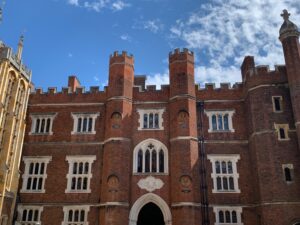
The rooms in which the Hampton Court conference was held, now completely remodeled, viewed from the Clock Court. Photo Credit – Hannah Berg
They took each of the king’s matters in turn. Archbishop John Whitgift replied first to each question as an official voice then opened the floor to the lower bishops. Discussion about private baptism was most significant, taking up three of the day’s five hours (Cardwell pg. 139). When lay baptism by women was raised, James explained that he would as soon have his child baptized by an ape as by a woman. Harley MS 828 records the bishops discussing legends of an ancient father baptizing with sand when water was unavailable. “A turd for the argument,” James responded: “he might as well have pissed on them, for that had been more like to water than sand” (Usher Vol. II pg. 342). When the Puritans raised this issue on day two, they were informed that it had already been decided. They were late to a fiery party that had all but concluded without them.
The time flew by because the king fielded all the points so masterfully, Barlow concluded. He lavished praise on the king and noted the biting irony that a king “brought up among Puritans” (meaning here the Scottish Presbyterians) and “schooled by them” should show himself as learned as the greatest scholars. Barlow could make sense of the irony because the king, though brought up under Puritans from the time he was ten, had always disliked their opinions. As was said of the Savior, “though he lived among them, he was not of them” (Barlow pg. 20).
James commissioned the bishops to continue discussing the remaining less important issues and come to final decisions before the final day of the conference. The second day (Monday) was “appointed…for the Opponents to bring in their Complaints;” the third and final day (Wednesday), “for the exhibiting of their [James’ and the bishops’] determinations in these points” (Barlow pg. 19). Chadderton took offense at this characterization of the Puritan spokesmen as being “appointed.” Arnold Hunt’s study of Chadderton’s copy of Barlow’s “Sum and Substance” which we discussed in our last post shows that he annotated at this point, “they knew no such appointment.” (Hunt pg. 212). In any case, Craig summarizes James’s role on this first day:
The first session of the conference at Hampton Court was without question the King’s conference, and he seems to have planned and conducted it with little thought to what points the [Puritan] ministers might bring before him on Monday. In the presence of the Privy Council the King presented a series of questions and concerns about his new church to the bishops, and either accepted or disputed their answers (Craig pg. 209).
The next day, Dudley Carleton wrote to John Chamberlain and summarized this first day. The bishops were actually being consulted by the king for advice, as opposed to the Puritans, whose complaints would merely be heard. The king’s sympathies were showing. Carleton also pointed out the visible distinction between the two parties even in their dress, emblems of respective conformity and non-conformity:
Yesterday the bishops with 4 or 5 of the deans were in Privy Chamber before the king and the lords of the council, to whom the king made a speech with great respect to them and their callings and told them he sent not for them as persons accused but as men of choice, by whom he sought to receive instruction and chiefly sought to be satisfied in the points of confirmation, absolution, excommunication, and private baptism….In conclusion the king seemed to be reasonably satisfied, only [he] did wish some alteration of scandalous words in the common prayer book, but the substance to remain, upon which he willed the bishops to advise and return to him again on Wednesday next. Meantime Patrick Galloway and his crew shall have their turn, and tomorrow they appear before the king. These two companies as they differ in opinions, so do they in fashions, for one side marches in gowns and rochets and the other in cloaks and nightcaps.
– Dudley Carleton to John Chamberlain, 15 January 1604, (Letter 21, pg. 53-60 here)
Many of the most important decisions of the conference were made here on this day, before the Puritan spokesmen even had a chance to bring their complaints, suggesting that their complaints matter less to the final decisions than sometimes thought. The game was rigged from the start. Still, on the second day, the spokesmen would “have their turn.” In our next post we will watch on as they finally get their audience with the king.
Posts On The Hampton Court Conference
- Hampton Court – Avenue And Dates
- Hampton Court – Attendees
- Hampton Court – Accounts
- Hampton Court – Activities Day 1
- Hampton Court – Activities Day 2
- Hampton Court – Activities Day 3
- Hampton Court – A New Bible
Hampton Court – Barlow’s Vindication And Extant Sources
In our last several posts, here and here, we have discussed the famous Hampton Court conference, which ultimately lead to the creation of the King James Bible. One or two more posts on the conference will be forthcoming, but along the way it seems appropriate to say a word about the primary sources used for studying the conference. Those without interest in such detailed historical investigation can simply skip this post and move to the next one.
The Lying Barlow?
The longest and most well-known account of the conference is the semi-official, The Sum and Substance of the Conference by dean of Chester William Barlow. Regular spokesman for and defender of episcopacy, he would go on to serve as a Translator for the KJB, and as head of the Second Westminster Company which worked on the KJB Epistles (Romans-Jude). C. S. Knighton summarized (pg. 2) Barlow’s attendance at the conference and the writing of the account, explaining that, “by 8 May Barlow had been chosen dean of Chester, as which he was installed on 12 June.” Yet:
This office (perhaps reflecting his origins in the north-west) had little claim on his attention; its chief importance was that it gave him status to attend the Hampton Court conference of 14–18 January 1604. Barlow was commissioned to write the official account of these proceedings, in which the hierarchy confronted its puritan critics, with the king in the chair. Publication was delayed by Whitgift’s death (29 February). On 12 May Barlow invited Cecil to accept the dedication, but the latter prudently asked to see the text first, and then avoided Barlow until the book had gone to press. Bancroft, the king’s secretary (Sir Thomas Lake), and the king himself allegedly approved Barlow’s draft, which appeared on 25 May as The Summe and Substance of the Conference (1604; STC 1456).
However, as it came off the press, “It was immediately criticized for misrepresentation; in particular, for making the king side comprehensively with the bishops.” This wasn’t news to Barlow. Knighton continues, “He had foreseen controversy,” offering as a disclaimer that he was only giving the “substance” of the conference, and not always recording verbatim everything said. In fact, he published as an appendix four different Puritan-slanted accounts; representatives of what he claimed to be a current bias in the opposite direction.
Trusting Barlow
Shortly, this skepticism about Barlow’s accuracy was overcome and his account came to be almost universally trusted by standard historians. Fuller noted in his 1655 history that, “Others complain that this Conference is partially set forth only by Dr. Barlow, dean of Chester, their professed adversary, to the great disadvantage of their divines” (pg. 193), yet used it as the basis for his own recasting of the conference in the form of dialogue. Strype in 1718 did likewise, suggesting (pg. 492) that it was “an authentic relation” written by Barlow “that the very truth of [the conference] may appear.” Cardwell in 1840 used Barlow as one of the main foundations of his treatment of the conference. Later in the century and after its turn, classic treatments of the conference like those by the eminent English historian S. R. Gardiner in 1883 and Roland Greene Usher in 1910 relied almost exclusively on Barlow’s account, revealing that while different interpretations of the conference had emerged, Barlow’s account had come to be accepted as a largely historically accurate picture. But would this trust last?
Doubting Barlow
Mark Curtis raised again the question in 1961, “How reliable is Barlow’s account?” He concluded that it was little more than, “a skillful piece of party propaganda.” He thus gave new prominence to the previously neglected “Anonymous Account” that had been printed in Usher (Harley MS 828), judging it “the best guide through this whole body of material,” which is “at all important points…consistent with the rest of the evidence.” He was influential and his conclusions were widely followed. Adam Nicolson, echoing Curtis without citing him, suggested that Barlow “was the official propagandist for the bishops’ cause, and his pamphlet was a carefully slanted version of events,” and even went so far as to claim boldly that, “Barlow…was lying.” Knighton represents this renewed distrust for Barlow’s account well:
The extent to which Barlow’s summary does indeed convey the substance remains central to the historiography of the conference. His report was long accepted as authentic, though differing interpretations were drawn from it. It has since been shown how he shaped his account for dramatic as well as polemical purpose. It is Barlow who gives James his famous line ‘No bishop, no king’, and who had him, riled by the advocacy of presbyterianism, bring the second day’s session to a close with the words ‘I shall make them conforme themselves, or I wil harrie them out of the land, or else doe worse’ (Barlow, Conference, 82, 83). Other testimony confirms that while the king made a spirited retort, he did not end the day on this bitter note. To an extent the truthfulness of Barlow’s version is of less consequence than the impact that it made. This lent powerful support to the view that the Stuart monarchy and the puritans were from this moment destined to collide.
Yet this distrust in Barlow prompted by Curtis may turn out to have been short lived. In 1981 Frederick Shriver pushed back against Curtis, suggesting that, “The ‘Anonymous Account’ cannot take the place of the Summe and Substance. It is far too short and far too thin….It is useful – even important – but supplementary only.” Hill pointed out that, historically, it has always been common to report the events of the conference with a certain bias. Patrick Collinson, in his earlier treatments of the conference (here and here), seemed largely to accept the judgement of Curtis, asserting that the Sum and Substance, “was itself a skillfully tendentious piece of party propaganda” (pg. 37), and a “journalistic coup” that “was not so much an exercise in fair and objective reporting as ‘a skillful piece of party propaganda'” (pg. 29). Yet in his most mature reflection on the conference before his passing, after the developments we will trace below, he came to the slightly more nuanced conclusion that, “The various accounts of the conference are all episodic and biased in one way or another, and all must be read with care” (pg. 199).
The Vindication Of William Barlow
The primary issue relates to how the king viewed the Puritan spokesmen. Did they receive a fair and impartial hearing, or was the king firmly anti-Puritan as Barlow seemed to suggest? Two recent developments have tended to vindicate Barlow as at least a moderately faithful witness.
Chaderton’s Copy Of The Sum And Substance
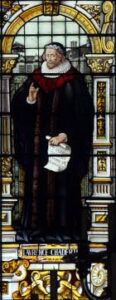
Laurence Chaderton, from the 1884 stained glass windows of Emmanuel College, in a scheme suggested by F.J.A. Hort, which emphasizes his role as preacher.
First, the recently discovered papers of Laurence Chaderton contain, among other things, his personal annotated copy of Barlow’s account. Arnold Hunt examined this document here. Chaderton was not only present at the conference on the important second day, he was also, as we noted in our last post, one of the leading spokesmen for the Puritans (whether he himself should be referred to as one is a debated point). He went on to be one of the notable King James Translators, in the First (Hebrew) Company at Cambridge which worked on I Chronicles-Song of Songs. He was educated at Christ’s College Cambridge, and was probably still a Catholic when he came, though he quickly converted to the Cambridge Protestantism. While a highly respected trilingual biblical scholar and theologian, he was perhaps most well known as a preacher and evangelist. When he gave up his weekly lecture in the pulpit at St. Clement’s Church in Bridge Street, which he had held for half a century, “forty divines signed a testimonial to the effect that they owed their conversion to his teaching” (Collinson, pg. 1).
Few could have more reason to see things differently from Barlow, and, perhaps more importantly, to contradict him in his annotations when given the chance. Indeed, among the numerous annotations he made in his copy there are a few that reveal his own memory clashing with Barlow’s printed report. Perhaps most important is in how the Puritan spokesmen were described. We noted in our last post some diverse views in characterizing these four men. Barlow had described them as “Agents for the Millenary Plaintiffs.” Yet at this point in his account, Chaderton took issue with this description, countering in the margin,
patients rather, being commanded to attend, nor but to hear [“and obey” written then crossed out] his majesty’s pleasure. God forbid we should be agents for any sect in religion or for any faction. Neither could we be for these, seeing none ever required this at our hands. No learning therefore can justify this, nor excuse the breach of charity.
[Spelling lightly updated]
For Chaderton, rather than agents they were patients, in the older sense of the word meaning, “A person who or thing which undergoes some action, or to which something is done; a (passive) recipient. Chiefly in contrast with agent.” (OED 4a). When Barlow later wrote that “the most grave, learned, and modest of the aggrieved sort” (the Puritans) were summoned by the king to the conference, Chaderton, as Hunt notes, “pounced on the contradiction,” arguing in the margin, “Being sent for how could they be agents for others? Being willed to speak how could they be plaintiffs?” As Hunt points out, “Barlow’s choice of vocabulary was clearly designed to serve a polemical purpose, but Chaderton’s efforts to disassociate himself from the puritan radicals were equally disingenuous” (pg. 212).
Some have emphasized this disagreement by Chaderton, like Collinson, who notes that Chaderton’s annotations show that he “took strong exception” to Barlow’s account (pg. 3). Yet for most, what is ultimately striking is how little he contradicts the historical scheme of Barlow. He seems to have accepted it as accurate except at a few minor points. Hunt noted that, “There is no doubt that Hampton Court was a fairly comprehensive defeat for the puritan cause,” and qualified that, “Admittedly, Barlow’s narrative may exaggerate the scale of that defeat,” but concluded that ultimately, “what Chaderton says here is arguably less significant than what he fails to say elsewhere.” The most crucial events of the conference “attracted no marginal comment” from Chaderton, and his annotated copy thus implies that at the crucial points, “Barlow’s account is a tolerably accurate record of what actually took place” (pg. 223).
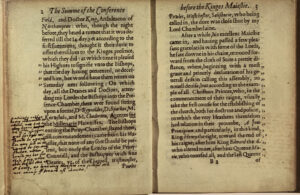
A page from Chaderton’s copy of Barlow’s work, showing an annotation disagreeing with Barlow. Photo credit – The Masters and Fellows of Trinity College, Cambridge, (C.9.125.fB1v). Worsley/Souden pg. 65.
David Norton, one of the world’s leading scholars today on the KJB, in his earlier work seemingly concurred with Curtis, cautioning that, “The accuracy of Barlow’s report is questionable. It was written at Bishop Bancroft’s request, read by the King before publication and scorned by those who were not of the Church party” (pg. 5, f.n. 3). Yet in his most recent work he seems to have been persuaded to a slightly different view by the evidence of Chaderton’s copy, noting that, “Chaderton, who was present at the conference, noted some vehement disagreements with Barlow’s designation of himself, Rainolds and two other puritans as ‘agents for the millenary plaintiffs’ (p. 2) in his copy of The Sum and Substance…but his silence on the discussion of a new translation suggests that there is nothing significantly wrong with it” (pg. 83, f.n. 6).
The Thesis Of William Craig
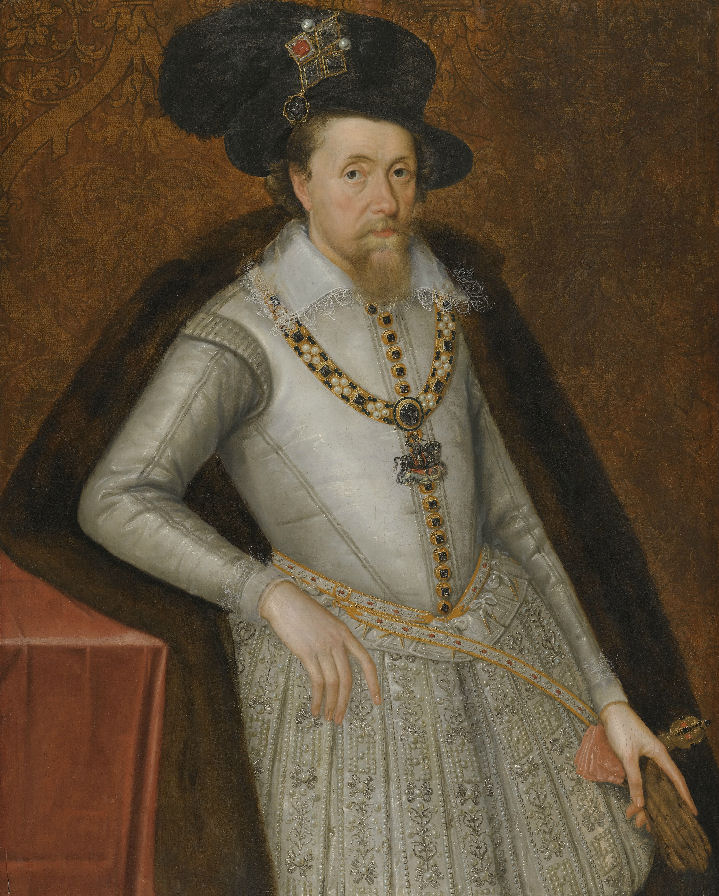
King James I, shown here in 1604, wearing the famous “Mirror of Great Britain,” by artist John de Critz, wrote a letter about the conference to Henry Howard, Earl of Northampton, towards the end of the conference.
The second development is the thesis of William Craig (noted in our last post) which examines each of the extant accounts of the conference. It is likely the most exhaustive examination of the sources to date, and it seeks to vindicate Barlow at length. Through a historical-critical analysis of the documents, Craig argues that Barlow’s account is a well-sourced eye-witness account, largely accurate (though not completely without bias), and, most importantly, corroborated by multiple outside sources at numerous decisive points. On the other hand, most of the accounts that agree with the Anonymous Account in Usher which has been championed against Barlow can be traced back to that account itself as a single source, and an anonymous one of doubtful provenance at that. The Anonymous Account itself, upon close inspection, “shows many signs of being not an eye-witness account but a composite of other earlier accounts of the conference” (pg. 246).
He thus concludes that, “Barlow’s Summe and Substance is not only indispensable because it is the longest and most detailed source we have, but also because it seems quite accurately to convey the substance of the conference” (pg. 247). In the official ODNB entry, Kenneth Fincham concurs (though apparently ignorant of Craig’s thesis), suggesting that, “Although Barlow’s account is relentlessly deferential to the king and spiky towards the puritans, it is the indispensable foundation text, three times the length of the ‘Anonymous account’ and broadly reliable, to judge from Laurence Chaderton’s annotated copy, in which he accepts large parts of Barlow’s narrative.” It would seem that, contrary to the claims of Nicolson, Barlow was not the one “lying.” The judgement of the editor of an 1804 reprinting of Barlow’s account is found to be relevant again in striking ways:
With respect to ourselves, when we consider that Bishop Barlow’s account of this famous Conference is admitted, by all parties, to be the only one set forth, and is accordingly by all parties continually quoted; that it was set forth, not upon his own authority alone, but with the assistance and allowance of several of the great men then present; that no objections to the authenticity of this account, of any consequence, were brought forward for a considerable time after it took place; and that the best of those objections were weakly and suspiciously urged, and never proved….without hesitation, we offer this Tract to the notice of the public, as well deserving attention; it has passed the ordeal of its enemies’s utmost malice, and is found to be a true and faithful work.
[Spelling lightly updated]
Extant Accounts
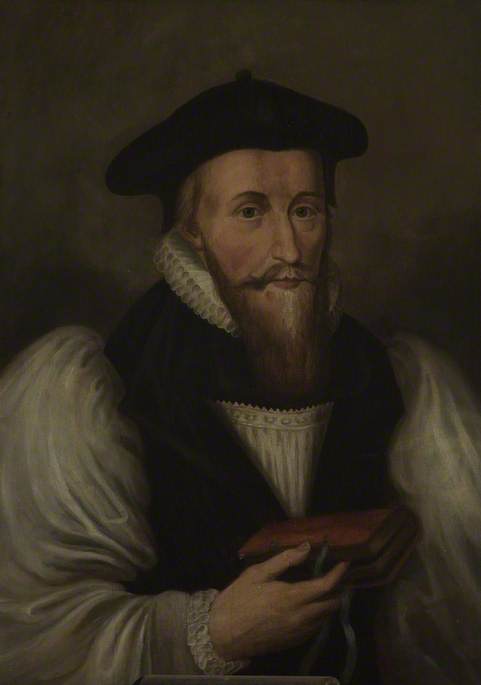
James Montagu attended the conference and wrote a letter to his mother describing it. Portrait 1608-1616. Unidentified painter.
By Craig’s count there are some sixteen different contemporary accounts of the conference, most of them short summaries in letters or diaries, nine of which come from participants or attendees of the conference, the rest of which are anonymous. For example, James Montagu, Dean of the Chapel Royal, and the first Master of Sidney Sussex College, Cambridge, attended all three days of the conference and wrote about it in a letter to his mother. Tobie Mathew, bishop of Durham, wrote a letter about the conference to Matthew Hutton, Archbishop of York. King James I himself wrote a letter about the conference to Henry Howard, Earl of Northampton. Others are noted below.
The two longest and by far the most important are the above-mentioned Anonymous Account in Usher, which paints the king as more friendly to the Puritans (British Library Harley MS 828 and Additional MS 38429), and Barlow’s, which paints him as decidedly anti-Puritan. The two accounts differ in important details. As Craig noted, “These two versions…cannot simply be harmonized into one: they present the King, the bishops, and the discussions between them in very different lights.” He categorizes the rest of the sources based on which major account they agree with. The accounts in Craig’s categories are;
- Those that agree with Barlow’s account;
- William Barlow, who took part in all three sessions, was asked to write a semi-official account, the well known, “Sum And Substance,” here. He also included three Puritan accounts which he reprinted at the end, which he shared as just samples of many going around.
- Dudley Carleton, present at Hampton Court during the conference, and probably in attendance, wrote a letter dated 15 January 1604 to John Chamberlain which gave a report of the first day of the conference (read here, pg. 53-60).
- James Montagu, Dean of the Chapel Royal, who was present for all three sessions, wrote a lengthy account in a letter to his mother on 18 Jan., the day the conference ended, printed in Cardwell, here.
- Tobie Matthew, Bishop of Durham, later Archbishop of York, wrote a letter to Matthew Hutton, Archbishop of York, the day after the conference, 19 January 1604. Printed in Cardwell, here.
- Those that agree with the Anonymous Account in Harley MSS 828;
- The Anonymous Account in Usher (British Library Harley MS 828 and Additional MS 38429) covers all three sessions of the conference.
- An anonymous letter, dated 15 January 1604 (here), also printed in Usher, covers the first day of the conference. It was the first account included as an appendix by Barlow.
- The Second Puritan account printed as an appendix in Barlow, here, covers all three days of the conference.
- Patrick Galloway wrote a letter to the presbytery of Edinburgh, dated 10 Feb. 1604. Sometimes the letter itself is claimed to have been corrected by King James himself, but as Craig points out, it is technically only the list of conclusions for which such a claim is made in the letter. Printed in Cardwell, here, in Calderwood here, and also reprinted by Gerald Bray here.
- Those that don’t give enough detail to be grouped with either;
- The Third Puritan Account in Barlow’s appendix, here, contains brief notes with little detail.
- The letter by King James I to Henry Howard, Earl of Northampton, (in Strype here, in Cardwell here, now best printed in Akrigg here, letter 101, pg. 220), presents a brief description of the king’s own take on the conference. Dated 17 Jan. 1604 by Akrigg, but 18 Jan 1604 or later by Craig.
- Thomas Sparke shared an account of the conference in “A Brotherly Persuasion To Unity And Uniformity…” STC entry here.
- Sir Roger Wilbraham, Master of Requests, recorded some details of the account in his journal. The relevant entry can be read here.
- Sir John Harington wrote a brief note with some details of the Conference, which can be read here.
- Usher printed, “An Anonymous Account in Favor of the Bishops” (not the same as the more famous Anonymous account from the Harliean manuscript above) from Baker MSS M.m.1.45, f. 155-157, here.
- Craig notes that a letter is preserved in the State Papers (14/6/37) by Ortelio Renzo, which has never been printed, which has a brief description of the Conference.
- The same letter contains a copy of another document described as “a brief note” with some brief mention of the conference.
- Craig notes that an anonymous account of the conference is found in volume IV of the Historic Manuscript Commission report on Various Manuscripts, written by F. H. T. Jervois.
It’s worth noting that a good case could be made for including the letter by King James I in the first category, clearly agreeing with Barlow. Nonetheless, I retain the categories proposed by Craig. A few other important documents are worth mentioning here again as well (other additional sources are covered in Craig’s thesis);
- The King’s proclamation 24 Oct. 1603 noting that the Conference date had been delayed – (#30 in Larkin/Hughes, here). Also in Cardwell here.
- The King’s letter 29 Oct. 1603 to Archbishop John Witgift asking how true the kinds of problems alleged in complaints, “so continually and so credibly delivered to us” (like the Millenary Petition) are (Akrigg #98).
- The King’s proclamation 5 Mar. 1604 reporting results of the council and authorizing the new prayer book (#35 in Larkin/Hughes) in Cardwell here.
- The King’s Commission 9 Feb. 1604 to the Archbishop John Whitgift detailing the minor changes that now needed to be made to the BCP. In Cardwell here.
- The canons of 1604, reflecting the changes (and especially highlighting the absence of greater changes) made after Hampton Court, in Bray here.

Tobie Matthew, Bishop of Durham, wrote a letter to the Archbishop of York about the conference the day after it ended. Unidentified painter, 1616.
We have now briefly noted each of the extant primary sources from which an examination of the Hampton Court conference must be made. We have suggested that contrary to once-commonly accepted notions, Barlow’s account is the most reliable source for reconstructing the conference, supplemented in important ways by other sources. In our next post, we will lay out a brief overview of the events of the conference, using these sources critically, before zooming in on the request for a new translation that lead to the King James Bible.
Posts On The Hampton Court Conference
Tea Subscription
Visit Us
Class aptent taciti sociosqu ad litora torquent per.
Call Us
(+880) 123 456 7898
(+880) 123 456 7898
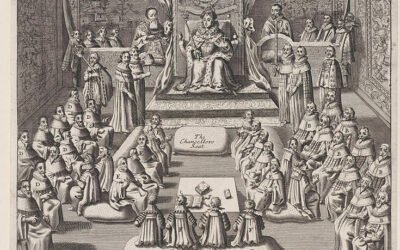
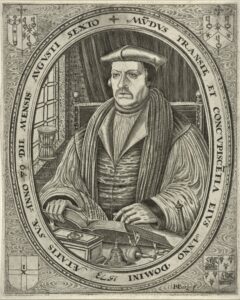
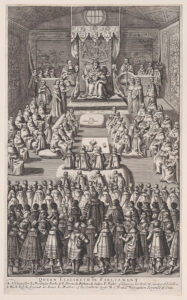
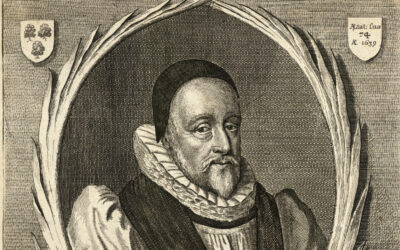
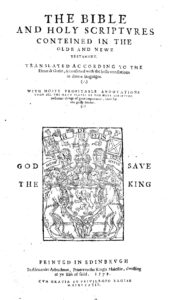
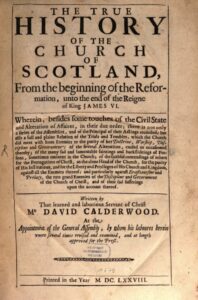


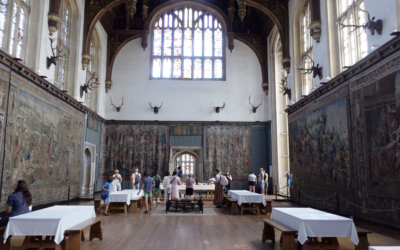

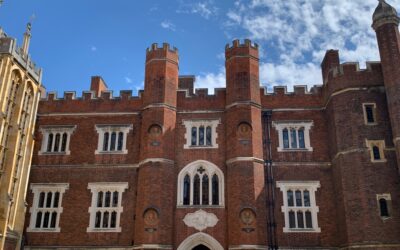

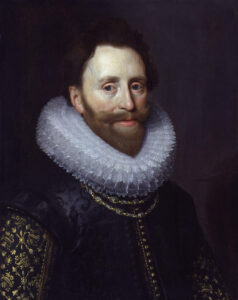
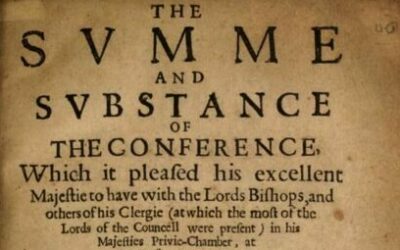

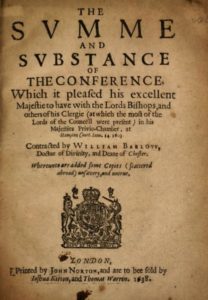
Comments